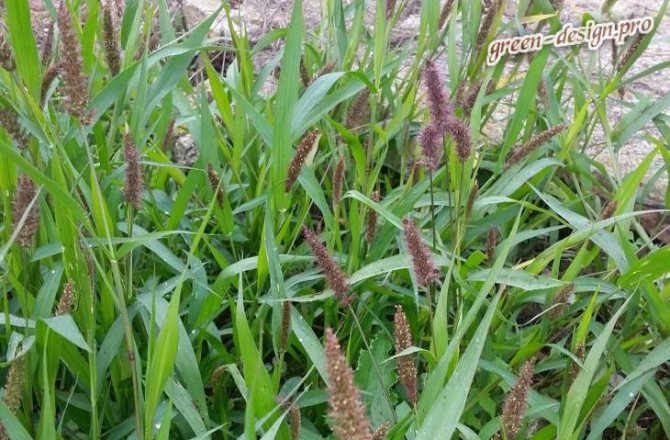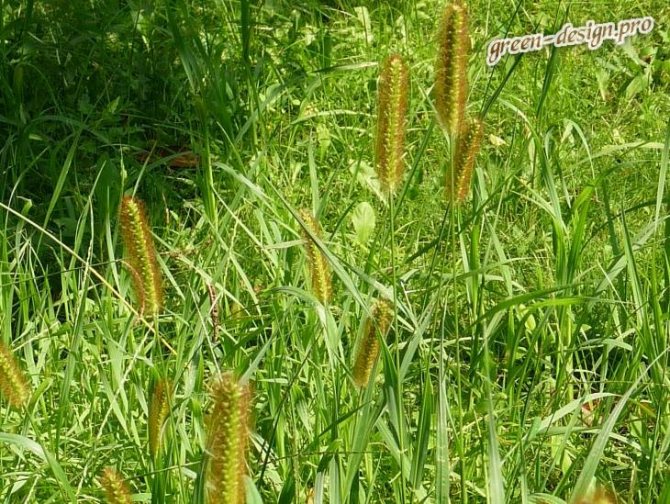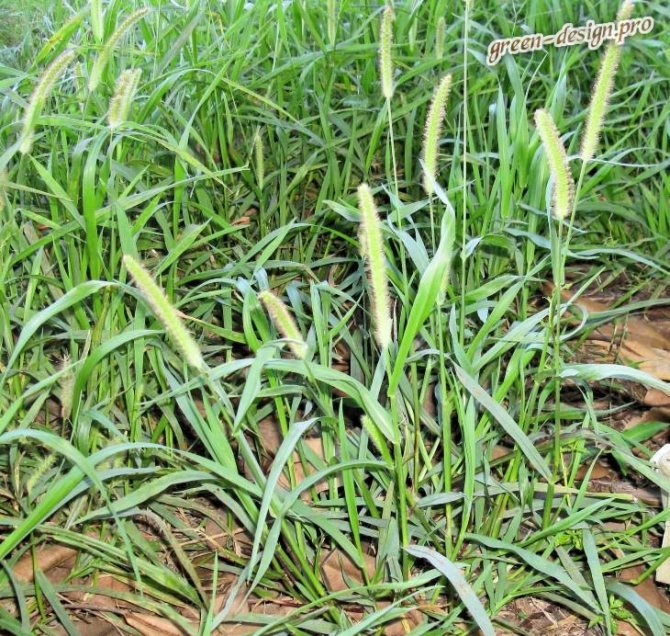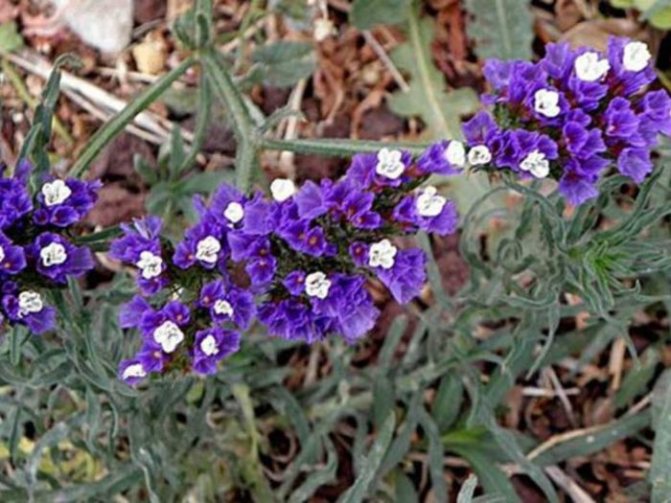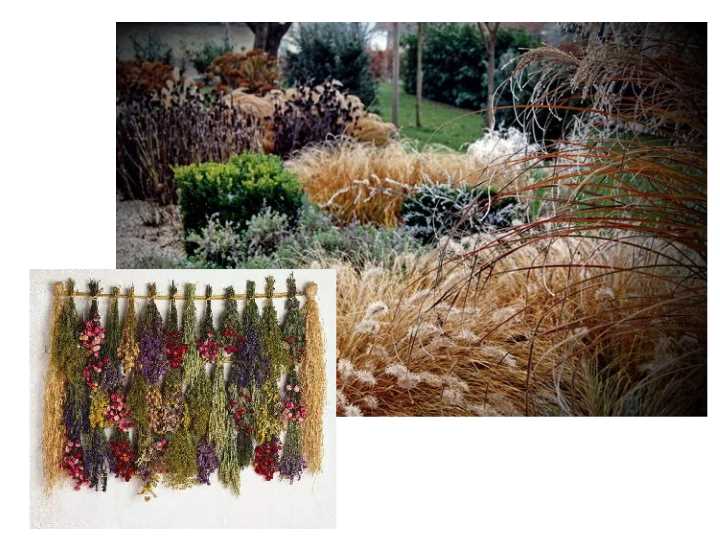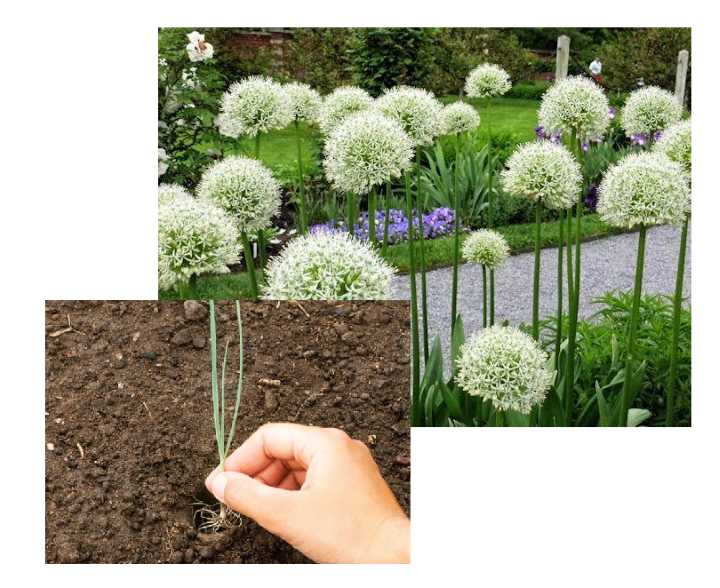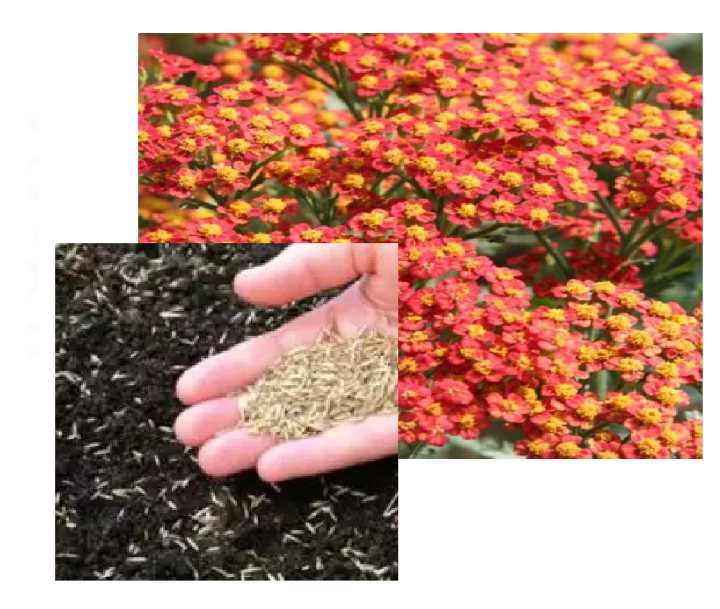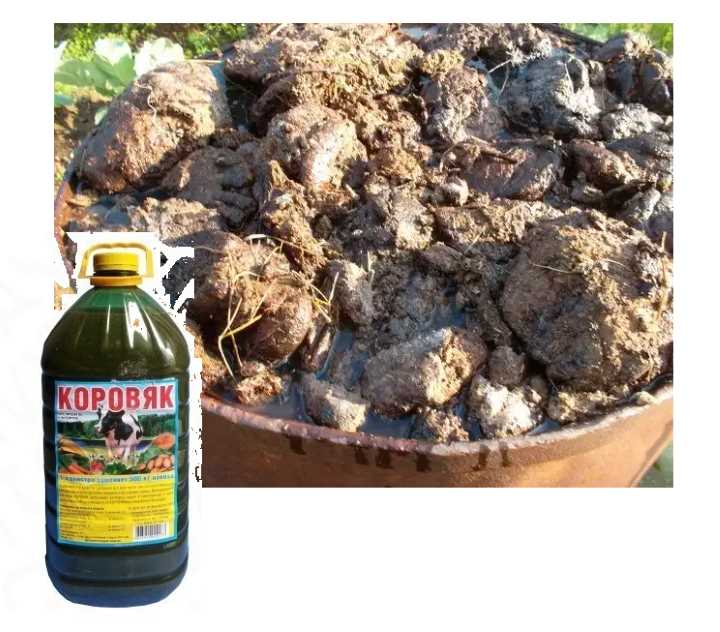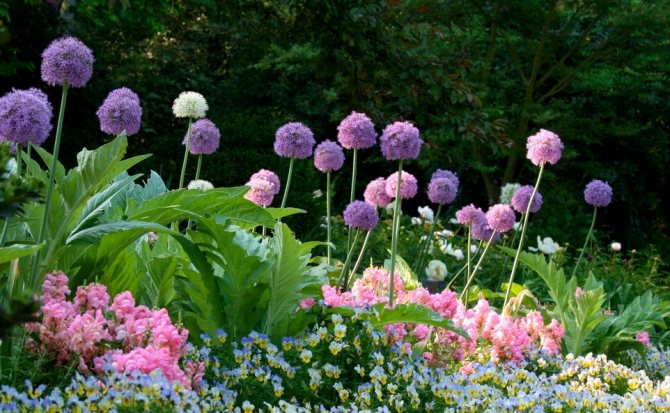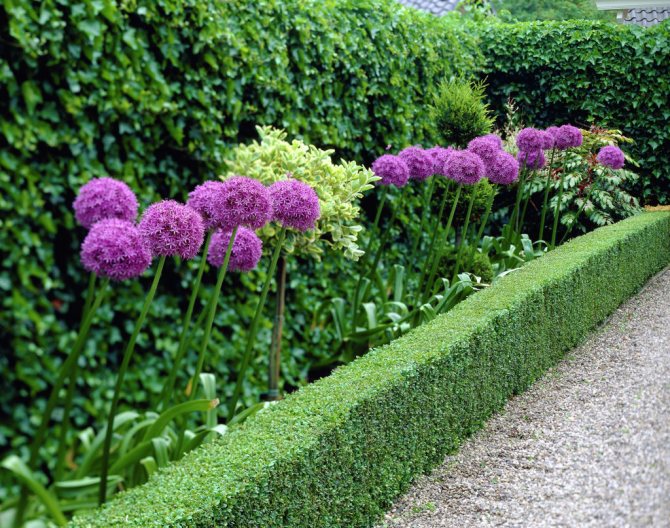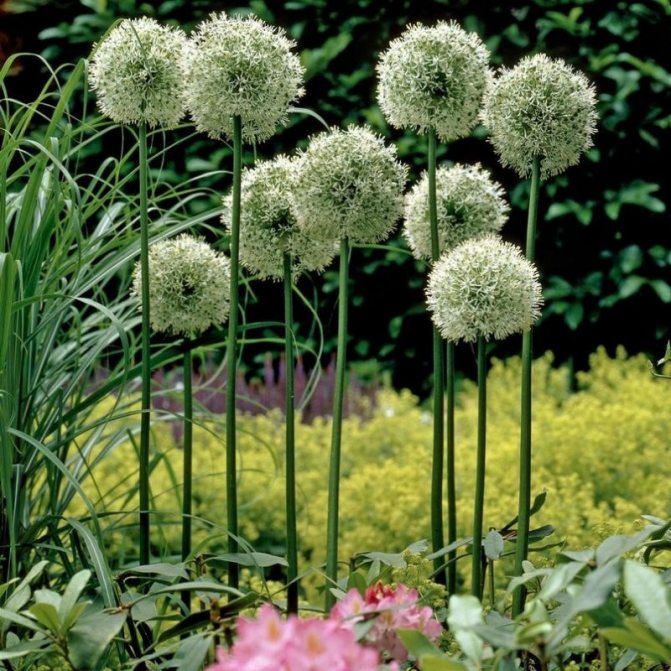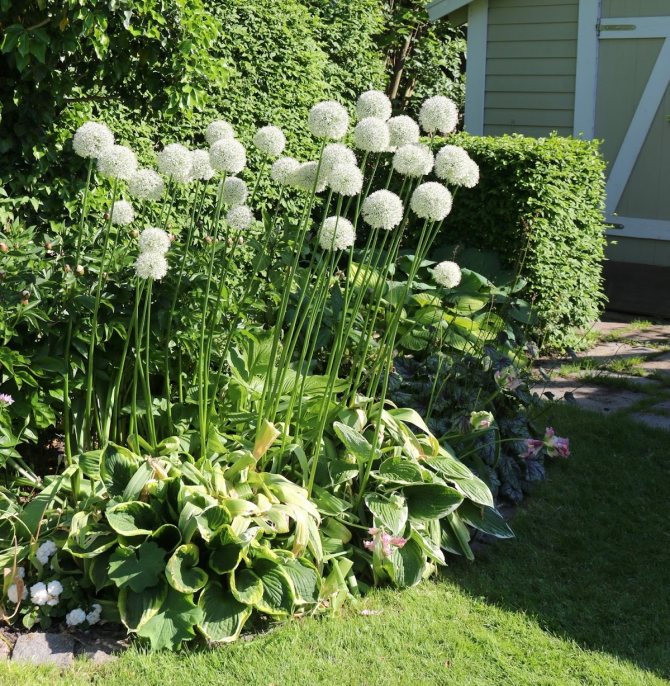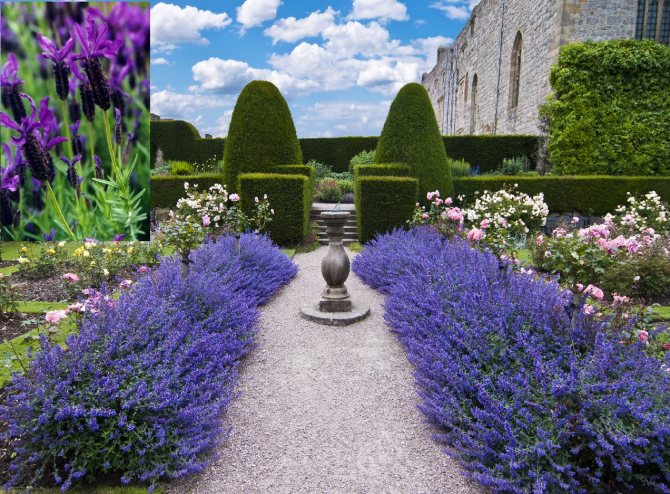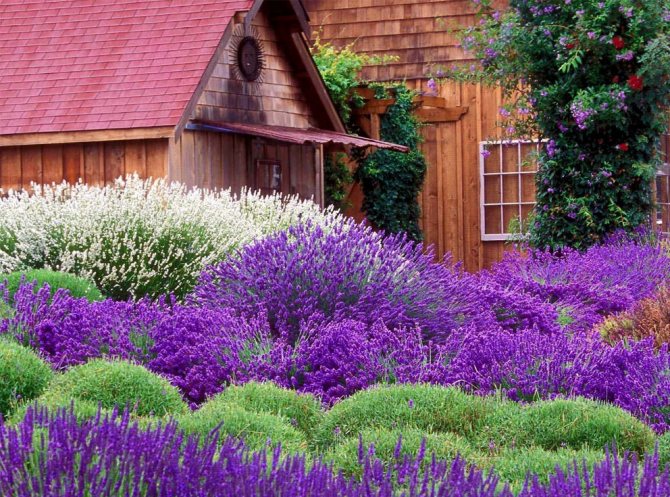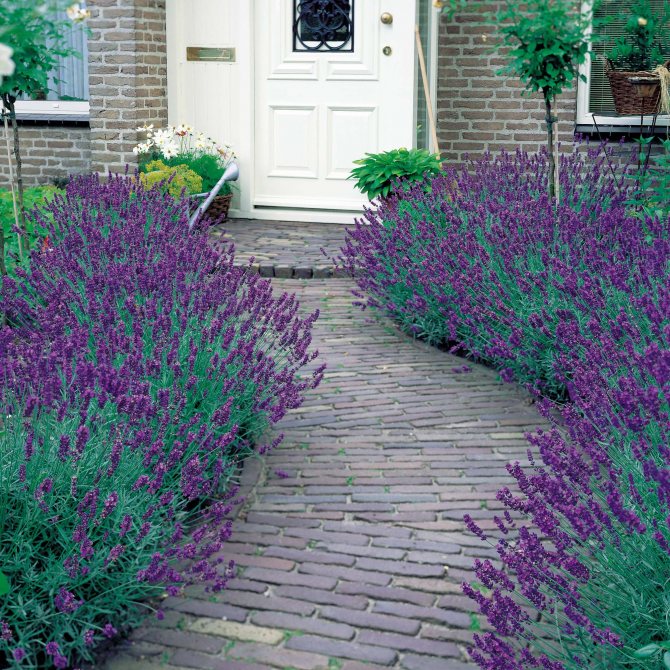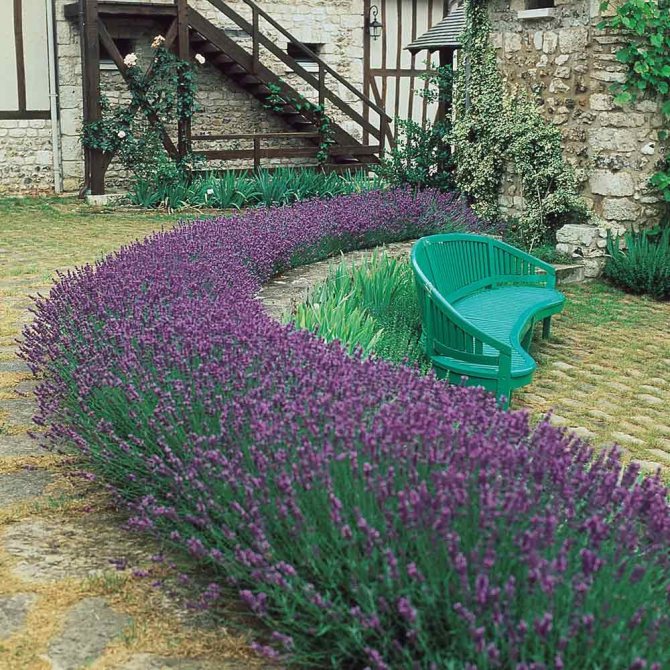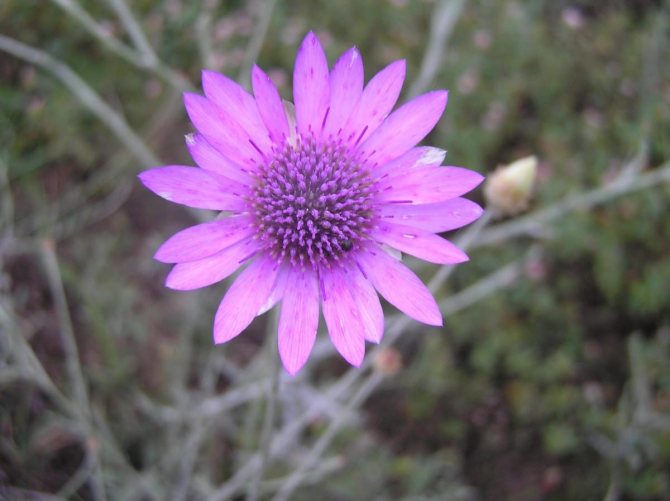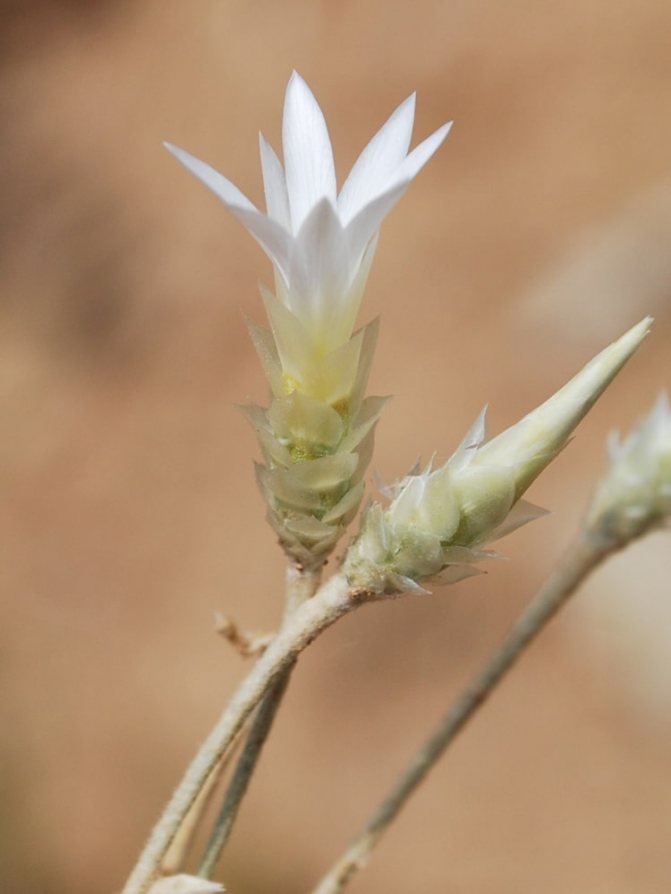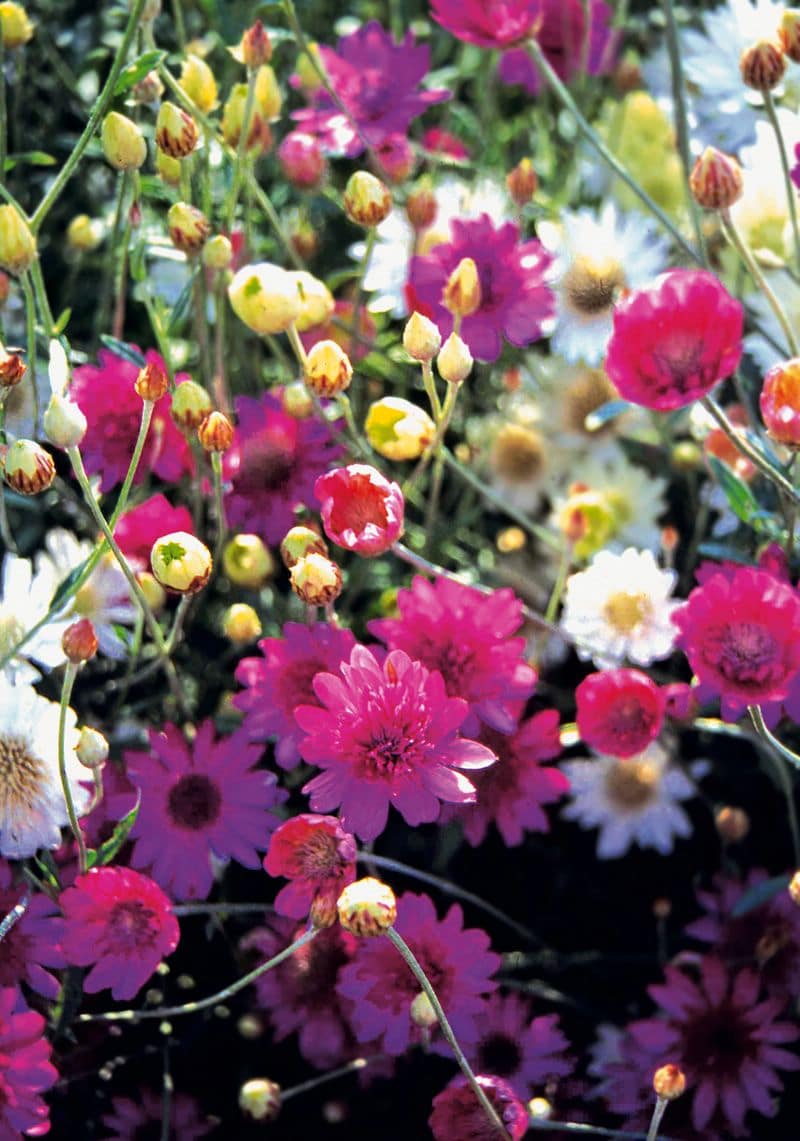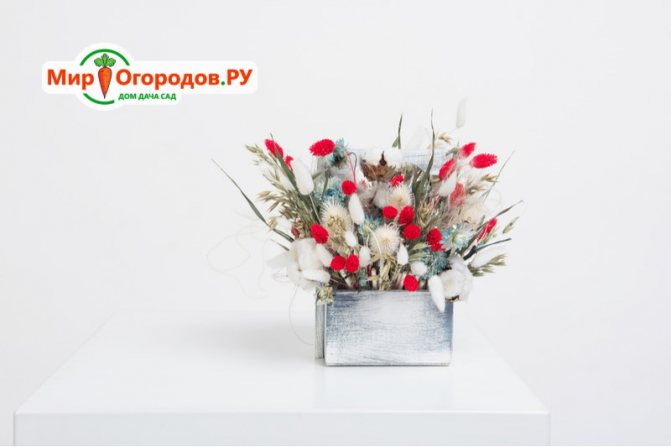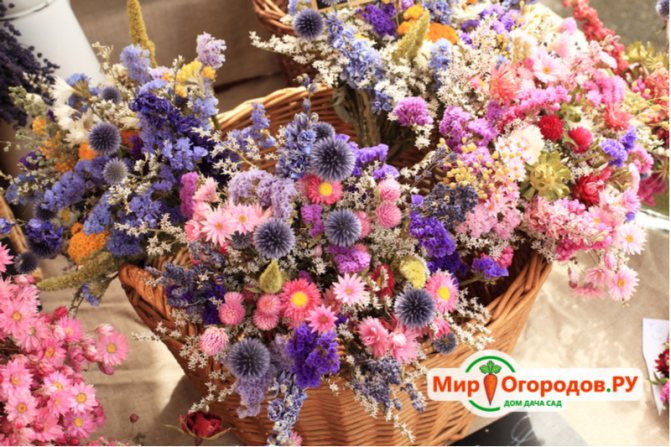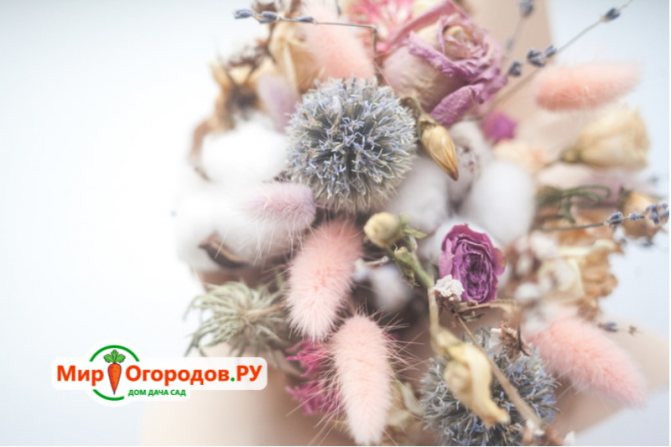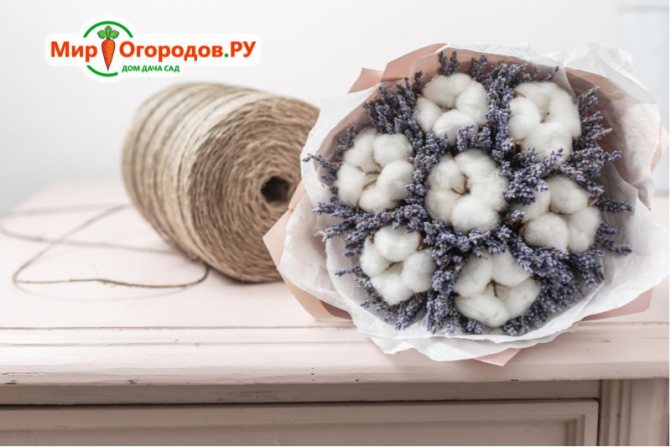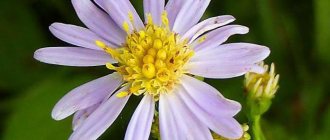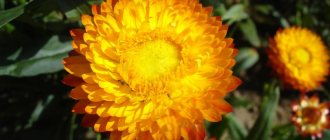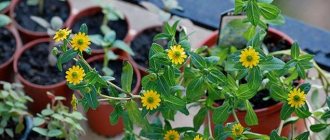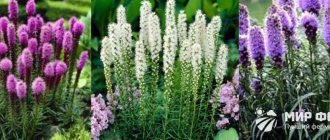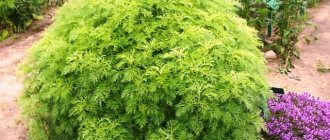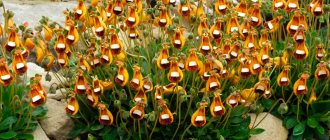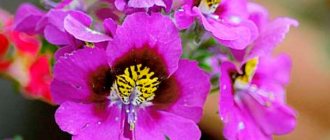Description of the plant
Annual culture, with straight branched stems, up to 60 cm high. The leaves of the flower are sessile, lanceolate, single inflorescences, collected in small baskets. The inner leaves of the plant are tough, sticking to thin peduncles.
Xerantemum is used in bouquets as a decoration
The fruit is an achene, it ripens at the end of August, the seeds remain viable for several years. The plant can reproduce by self-seeding. Xerantemum has been cultivated since 1570.The most common varieties include:
- "Rose" - with double inflorescences;
- "Purple" - with crimson inflorescences.
The Xerantemum flower looks both in individual and group plantings, suitable for cutting and drawing up dry bouquets. The color of the inflorescences can be pink, white, purple.
Distribution and habitats
The habitat of xerantemum is the southern and western part of Europe, the Mediterranean, the Balkans and Asia Minor. Plants grow best in the steppe, on chalk outcrops, prefer dry slopes and low mountains, they can also be found on sandy soils.
Check out such dried flowers as: amaranth, celosia, helihrizum, craspedia and tansy.
Growing and care
The plant propagates by seeds, for this you need to fertilize part of the soil at the beginning of spring, moisten the substrate, drain it to a depth of 0.5 cm, sow seeds, cover the sowing site with foil to create a greenhouse.
Seedlings after 2-3 weeks dive into separate containers or planted in open ground, carefully transporting the root system with a lump of earth. Under favorable weather conditions, the plant will bloom in the same season.
Plant care criteria:
- light nutritious soil;
- moderate watering;
- weeding;
- loosening the soil.
Growing xerantemum needs to be done in sunny areas, but it is cold-resistant. To the north, it is better to use the seedling method, otherwise the plant may not bloom at all.
Xerantemum from seeds quickly takes root, at first it requires regular watering, after which this procedure can be stopped altogether and watered only on dry hot days. The plant looks great with astrantia, salvia, yarrow, in a mixed type as a curb crop.
The plant is not damaged by pests. Withstands temperatures up to +20 ° C. In winter, it requires insulation, in open ground it does not tolerate even weak frosts - the root system dies.
Dried flowers retain their shape for several years. The photo of the xerantemum attracts with a riot of flowering, bright color, lush leaves and a strong stem. This is an ornamental plant for decorating landscape compositions and original flower bouquets.
Xeranthemum (lat. Xeranthemum) is a genus of brightly flowering plants from the Asteraceae family. The second, no less common name is dried flower. In natural conditions, plants are found in Asia, southern Europe, the Mediterranean, mainly on stony soils of meadows, near roads or vineyards.
Xerantemum annual
Landscape decoration with tall dried flowers
Low-growing dried-flower plants are easier to use when decorating a garden or a summer cottage: in flower beds, flower beds, to knock out a path, but bright and noticeable astilbe or bows are so expressive that a mistake will cost more. Let's consider some techniques using the example of decorative onions (Allium) and lavender.
A bright accent is a giant decorative bow. In the photo below, varieties with purple inflorescences are Allium gladiator or Allium globemaster, with lush white heads variety - Allium mount everest. It looks great with hosts, in a mixborder with other lush flowers, next to clipped green hedges. It will be a mistake to supplement it with delicate, graceful, or too small flowers - it will suppress them with its power.
Lavender is very popular. It has already been said above that it looks great along the paths. But that's not all. It goes well with roses. It is good in wild, "unkempt" compositions, but because of the exquisite lilac color it can be an excellent companion to trimmed trees, cobbled paths, garden statues and decor in a classic or even palace style. Due to the height of the plants, it can form a line separating one zone of the garden from another. There are more examples in the photo below.
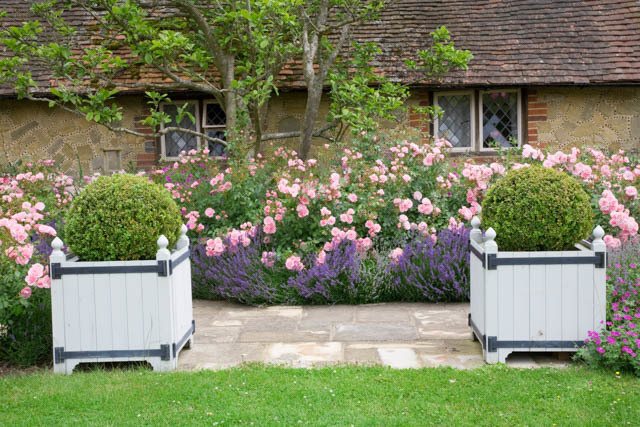
'Bonica' rose and 'Hidcote' Lavender. The garden is at High Canfold Farm, Surrey Lavender Path at the east end of the rose garden at Polesden Lacey. NO G. CARDS UNTIL SEPT 2006
Description
The genus Xerantemum is represented by herbaceous annuals, reaching a height of up to 60 cm. Stems are branched, erect, covered with a white edge. The leaves are alternate, almost sessile, narrow (about 3 cm long, 0.5 cm wide).
The inflorescence is represented by a single hemispherical basket with several rows of petal-shaped scales, up to 4 cm in diameter. The color of the petals (actually reed flowers) can be white, purple, pink, red or purple. The inflorescences-baskets in wild species are usually non-double, in decorative ones - double or semi-double.
Xerantemum, variety Rose
Abundant flowering begins in July and lasts until September. After drying, the inflorescences retain their shape and color for a long time.
The brownish-gray fruits ripen in August and have the shape of a wedge-shaped achene with a small tuft. The seeds are very small, there are about 700 seeds in 1 g. They remain viable for 2-3 years.
The genus is represented by 6 species, but only Xerantemum annual (Latin X. Annuum) is used in floriculture. In its inflorescences, the petal-shaped multi-row wrapper is longer than the petals themselves and has the same color, which can be white, lilac or pink. The most attractive varieties:
Rose -with double pink inflorescences, 3.5 cm in diameter; Violet-purple - with bright crimson-violet inflorescences about 3 cm in diameter.
Garden decoration with Xerantemum
Landscape designers love to use Xerantemum in their projects because of its unusual beauty and unpretentiousness. Flower beds, rockery borders will look great if you decorate them with these flowers. Planting them in groups will create the appearance of natural vegetation on the lawn. Even when the plant stops blooming, it does not cease to decorate the garden area and continues to give aesthetic pleasure.
It can be safely planted with Iberis, Yarrow, Astrantia or Escholzia.
The use of xerantemum by florists:
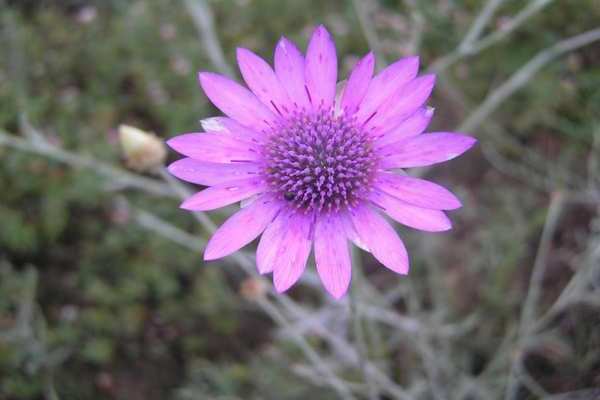

This flower is valuable not only for landscape designers, but also for florists who grow them in order to make unique and beautiful compositions of fresh and dried flowers with their participation.
These wizards are able to make sure that within two years, the buds will retain their shape and bright colors.
In order to achieve this, the cut is carried out until the buds fully open.Further, bunches are made of them, which are dried in a dry, shady and well-ventilated room, suspended so that the inflorescences look down. To preserve the brightness of the buds, they must be dipped in hydrochloric acid for 4 seconds. It should be mixed with water in a ratio of 1 hour of acid to 12 hours of water. The solution should be well mixed and the buds should be freshly cut. After they need to shake slightly and send to dry.
Xerantemum will be perfectly combined with Kermek, Helipterum, Gelichrizum, Kachim in bouquets of dried flowers. Lavender, yarrow, astilbe will also be a good partner.
Growing and care
Xerantemum prefers sunny locations. It is not picky about the soil, but it grows better on light nutritious soil with good drainage. The plant is drought-resistant, regular watering is required only during the transplanting period and until it is completely rooted. With the appearance of buds and during the flowering period, it is recommended not to moisten the soil. Watering is allowed only in extreme heat.
Xerantemum does not need special care. Weeds should be removed several times during the season and the soil should be loosened. The dried flower is resistant to various diseases and is of little interest to pests.
Why are dried flowers good?
Some plants, completely covered with buds, are interesting in spring, others - in summer, during flowering, and still others - in autumn, when the fruits ripen.
And when it is winter outside the window "... the quiet music of the snow, the secret singing of the stars", then in winter compositions and bouquets they create a special mood in our house, reminding us of the calico of summer days.
And also dried flowers know how to look so faithfully and with such hope in the eyes, as if they remind us: “Do not forget in the fall, when she gallops on a frisky horse, blue-eyed and red-haired, not sparing paints, she will dress forests in crimson and gold, collect seeds, prepare material for winter bouquets, compositions, paintings ... "
And I know that if this happens, then with the arrival of spring everything will be repeated, and again my lovely dried flowers will delight me with a bright carpet, arranging a charming flower show as a sign of gratitude for your attention and care.
And the concern is the smallest: to weed in time and water, if the rains keep you waiting.
Each plant from the group of dried flowers grows wild in its homeland. They are undemanding to the soil, resistant to natural stress, and drought-resistant.
Reproduction
The dried flower is propagated by seeds. When growing xerantemum from seeds, at the beginning of spring, sowing is carried out in a container with a light, loose moist substrate to a depth of 0.5 cm, covered with a film or a glass jar. For seed germination, the optimum temperature is within + 20 ° C. Young seedlings dive in 3 pieces. in separate pots with a diameter of 9 cm.
Xerantemum before flowering
In open ground, seedlings of xerantemum can be planted at the beginning of summer with a distance of about 25 cm. In order not to injure the root system, it is necessary to save an earthy lump. Until young plants are thoroughly rooted, the plantings of xerantemum should be watered regularly.
It is allowed to sow seeds directly into open ground, preferably under a film. The sprouted seedlings will need to be thinned out. Plants grown in this way will bloom only at the end of summer in good weather conditions.
TOP-6 universal dried flowers: growing and creating decorative compositions
Flowers are a beautiful creation of nature that can delight the human eye. The beauty of growing flowers in a flower bed is continued by the bouquet beauty in a vase at home. For bouquets, you can use any flowers, but dried flowers will be the most long-lasting. They are able to stand in a bouquet for a very long time, in contrast to living ones, which wither within a week.
A characteristic feature of dried flowers is the preservation of their shape and primary color after drying.Growing such flowers will not be difficult, since dried flowers are unpretentious to the soil and do not require special care, they are drought-resistant, they tolerate stress and weather changes well. In the wild, dried flowers grow in meadows and fields. You can plant a wide variety of dried flowers on your site, and they will delight you with their flowering.
Let's take a closer look at the most popular types of dried flowers.
Gelikhrizum (immortelle)
The immortelle reproduces by sowing seeds. They are sown for seedlings in a greenhouse in early April. After a couple of weeks, the seedlings must be dived and in mid-May they can be planted in the garden in a permanent place. The plant prefers loose, fertile soil. Negatively refers to waterlogging. Plant height - 85-90 cm. The plant blooms in the second decade of June. The flowers are tubular yellow, which are surrounded by bracts of different shades. For bouquets, gelichrizum is very important to cut off in time, when the buds appear or at the very beginning of their dissolution. In this case, they will retain their color and shape for several years.
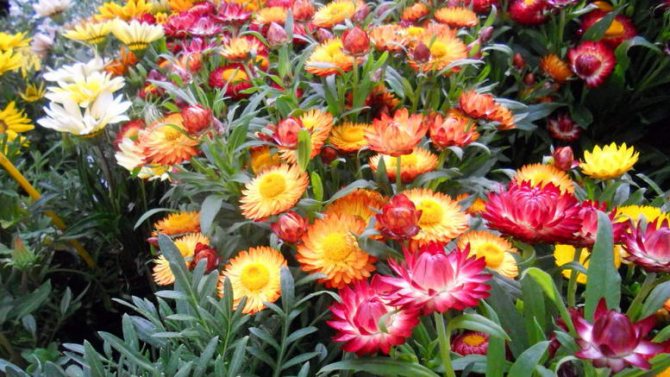

Statitsa (Kermek)
Kermek is grown by seedlings. Seeds are sown in the greenhouse already in February. And on the site in May at a distance of 20-25 cm from each other. The plant begins to bloom in the second decade of June and before the frost itself. Flowers have a wide variety of colors. The height of the plant reaches up to 75 cm. For a bouquet, the statice inflorescence is cut off when it has completely blossomed and can be dried without hanging.


Gypsophila
Also grown through seeds. They are planted directly into the ground according to the 15x20 scheme. Germination is observed in about 10 days. Flowering occurs in June-July. It blooms with small white flowers, collected in paniculate inflorescences on a very branched stem. Plant height - up to 120 cm. Some varieties can form spherical bushes. It is subject to a cut when the boxes begin to turn yellow. It is highly valued for its decorativeness and delicacy. Gives the bouquet airiness and lightness.
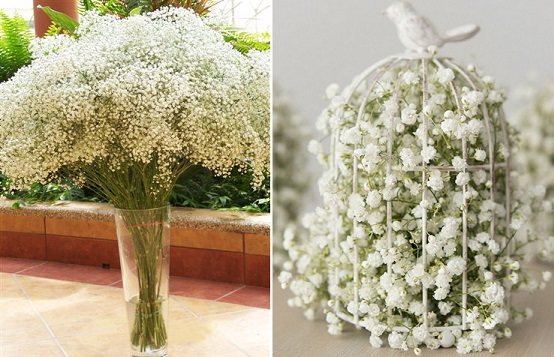

Gomfrena
Sow seeds for seedlings in April. After a couple of weeks, seedlings may already appear, and after 2 weeks it is worth diving the seedlings into a large container. They are planted on a garden bed in June, keeping a distance of 20-25 cm between seedlings. Gomfrena prefers sunny areas. The plant will bloom only in hot weather. Plant height up to 40 cm. Flowers are small, which are collected in globular inflorescences, purple, white, pink, lilac color. The plant for dried flowers is cut in full dissolution and hung upside down with its heads for further drying.
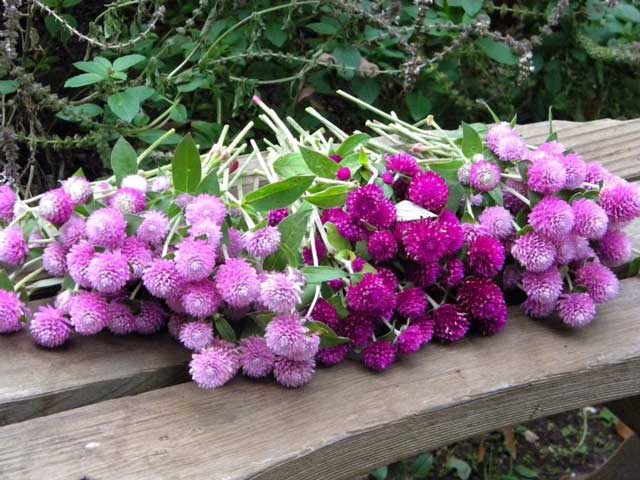

Physalis
It should not be forgotten that there are varieties of physalis that can be eaten (vegetable). Outwardly, there are practically no differences, only the vegetable inside the box ties the fruit that looks like a small underripe tomato. Physalis seeds are sown directly into the soil in April. The distance between plants is kept up to 60 cm. Physalis blooms from mid-July to late August. This plant is prized for its decorative orange or fiery red lanterns. The flowers are cut on a bright, sunny and dry day. There should be no moisture or drops on the plant. The cut is made at the stage of flower blooming you like. Then remove the green leaves from the branches and hang them upside down in a dark, well-ventilated area. After 20 days, the plant is completely dry.
Nigella Damascus
Nigella is sown directly into the ground. Seedlings appear in a couple of weeks. Loves drained soil, but unpretentious to sunlight, grows well both in the sun and in partial shade. The bushes of the plant are 40-50 cm high. Branches well. Flowering occurs in early July and lasts until the second half of September. Flowers can be pink, white and blue. It retains its decorative effect for a very long time due to the shape of the flower.
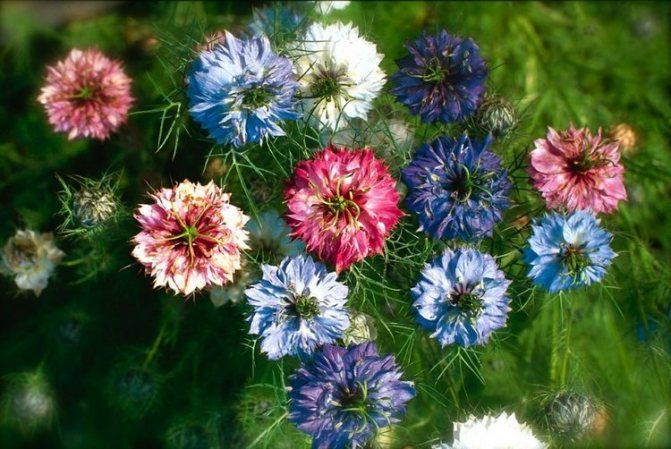

For dried flowers, not only the flowers themselves are used, but also the seed pods.Sometimes the cultivation of dried flowers is not the main goal, but when interesting inflorescences and flowers of unusual beauty appear, you want to preserve this beauty for a longer time than flowering.
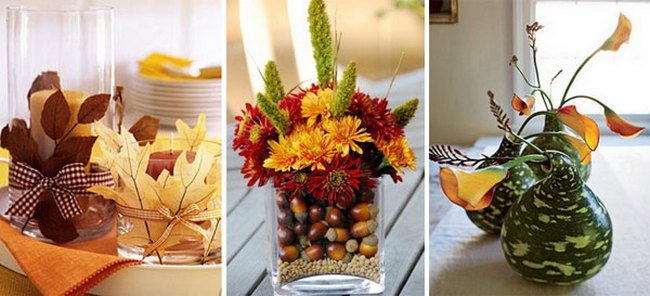

So we resort to drying, and thus dried flowers are obtained, the list of which expands every year. It is only necessary to pay attention to the fact that each dried flower plant is dried using a different technology for better preservation.
Using
Xerantemum is planted in various flower beds, rockeries and rock gardens. Can be used in single or mixed plantings. It goes well with millennial, astrania, salvia, etc.
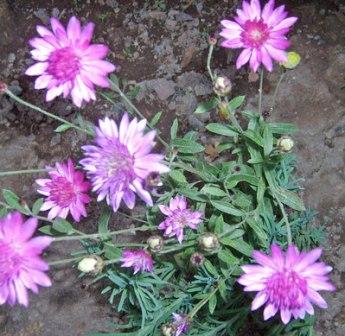

Xerantemum in the landscape
From dried inflorescences, you can create bouquets and decorate rooms. To do this, stems with buds that have not fully blossomed must be cut off, collected in bunches and hung in a dark room with good ventilation. Dried xerantemums retain their color and shape for many years.
The name "Xeranthemum" comes from the Greek words "xeros" - "dry" and "anthemon" - "flower", for its widespread use in dry bouquets.
Homeland - the Mediterranean, the southern regions of the European part of Russia, the North Caucasus, the Balkans. There are 6 known species. Herbaceous annual plants, erect, densely or tomentose pubescent. The leaves are arranged in regular order, elongated or lanceolate. Inflorescences are solitary, white, pink, purple. The inflorescences are decorative by large petal-shaped scales of a multi-row wrapper. The fruit is a wedge-shaped, brownish-brown achene with a yellow or brown crest. 1 g up to 700 seeds.
Xerantemum annual
- X. annuum L. Homeland - the south of the European part of Russia, Crimea, Ciscaucasia, the south of Western Europe, the Mediterranean.
Annual plant, herbaceous. Stems are straight, highly branched, 50-60 cm tall. Leaves are sessile, linear-lanceolate, arranged in regular order. Stems and leaves are silky tomentose pubescent. Inflorescences are single baskets, white, pink, purple, 3.5-4 cm in diameter, on long, thin peduncles. The flowers are small. The inner leaves of the multi-row wrapper of the inflorescence are petal-shaped, scarious, rigid, much longer than the flowers and of the same color. Blooms in July-September. The fruit is achene. Seeds in the middle lane ripen in August-September, remain viable for 2-3 years. In culture, since 1570.
Plants with non-double inflorescences are more common in nature. In floriculture, semi-double (X. a. Var. Ligulosum hort.), Double (X. a. Var. Plenum.) And multi-flowered (X. a. Var. Multiflora hort.) Forms and varieties are mainly used.
On sale at the present time there are only mixtures of colors of terry or semi-double forms of xerantemum. However, varieties of this culture are also known:
- rose flower
- with double inflorescences 3.5 cm in diameter and pinkish scales - "petals";
Violetpurple
- with inflorescences 3 cm in diameter, painted in purple with a raspberry tinge.
Location
: areas in sunny places, cold-resistant.
The soil
: not demanding, but thrives on light nutritious soils. To obtain friendly shoots in the initial growing season, it requires a sufficiently moist soil, and from the moment budding and flowering begins, it prefers drier conditions, not requiring watering.
Care
: uncomplicated and consists mainly of weeding and loosening the soil around the plants.
Reproduction
: sowing seeds in March - April in boxes. Seedlings dive 3 pieces in 9 cm pots. Seedlings are planted in the ground at the end of May - beginning of June according to the scheme 25 x 20 cm. You can sow in open ground ridges, but flowering will not occur until August with good summer. In the latter case, seedlings must be sorted. In the middle lane and to the south, sowing in open ground is preferable, since the plant does not tolerate transplanting well. To the north, it is better to grow in seedlings, otherwise the plant will bloom too late.
Using
: in landscaping, Xerantemum can be used in border plantings, in flower beds and in rockeries, but basically it goes like an immortelle for cutting, which is done when the baskets are not fully opened.
For drying
inflorescences of xerantsmum are cut in the phase of incomplete dissolution and dried by hanging in bunches in a dry, shaded place. To give dry inflorescences a brighter color, before drying, they can be dipped in a weak solution of hydrochloric acid (1:12) for 2-3 seconds, then gently shaken and dried in the usual way.
Xerantemum is a beautiful, unpretentious annual flower that has long been used as an ornamental plant in landscape design and to decorate flower beds. Learn about the botanical description of the flower and the process of growing at home.
Bulbous dried flowers
Bulbous dried flowers are nothing more than a lilac decorative onion. It is grown in almost all gardens from mid-May to late autumn.
Many make the mistake when, after dropping the inflorescences, it is sent to the heap for further disposal.
In most cases, summer residents use the fast-growing Aflatunsky onion, in rare cases: Christophe or Schubert.
In order to use it in a dry bouquet, it is necessary to cut it off earlier than the time when the onions will fully open the inflorescences. At the same time, it is necessary to pay attention to the fact that compositions with its combination are formed before drying, otherwise it will break off (too fragile).
In the process of growth, decorative onions can reach a diameter of about 40 centimeters, which makes an incredible impression on others.
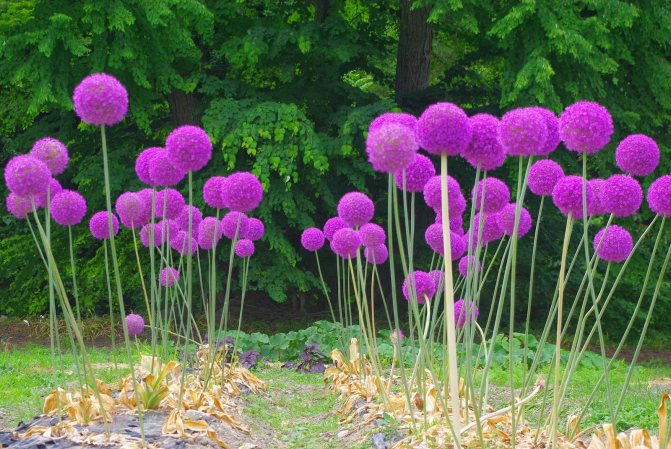

If we talk about the care itself, then it is enough here to make sure that there are no extraneous grass (wild) near these plants. It is enough to remove the weed within a radius of 10-15 centimeters around the trunks.
Particular attention must be paid to watering. These plants do not like abundant watering, but also dryness. For this reason, it is recommended to water it every 3 days in summer, and in other seasons (of course not in winter) - once every 5 days.
The cultivation is very simple - small holes are made or a ditch is made and the seeds are laid out. Germination appears after 10 days.
If we talk about landscape design, then an incomparable option with a bow can be seen in the photo:
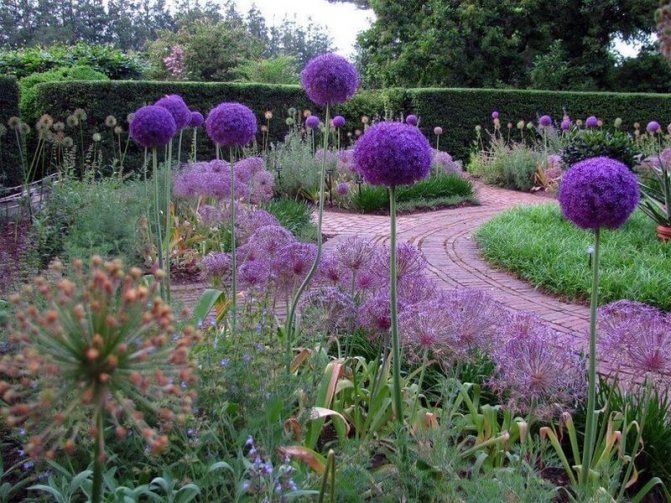

Botanical description
Xerantemum is an annual plant that belongs to the Asteraceae family. It began to be grown at home at the end of the 18th century in the southern regions of Europe, but soon it spread throughout the world, thanks to its unpretentiousness to growing conditions and unusual beauty that persists even after drying. The flower is characterized by the presence of an erect stem, which can reach a height of 60 cm. Narrow, long lanceolate leaves are alternately planted on the stem.
They reach about 3 cm in length and 0.5 cm in width. The stem is covered with white villi. Inflorescences look like baskets, represented by hemispheres. Ornamental species of this plant with double or semi-double inflorescences can be white, purple or pink. The flowers are small, no more than 3 cm in diameter. It blooms from early July to September. Flowering amicable and abundant.
Ripening of seeds on a flower occurs at the end of summer.
The seeds are quite small, grayish, more than 700 seeds are concentrated in one gram, they remain viable for up to 3 years. The genus of xerantemum has 6 species, but only xerantemum is used in floriculture.
Teasel sowing
And a special love is the sowing tease, a tough and thorny biennial plant. Grows well in open, sunny places with well-drained and fertile soil.
Being a weed, not very picky, it can endure bad conditions, but then the specimens are poor, and the "cones" are small.
Teasers grow up to 2 m in height.Stem leaves grow together in pairs to form cups surrounding the stem. The heads ("cones") are cylindrical, up to 12 cm long, very beautiful, strong.
An excellent persistent floristic material that can be “silver”, “gilded”, “snowed”, and most importantly, easily and effortlessly dyed. In the composition, the color is most striking.
You can experiment with tease, trying different ways to harmoniously combine flowers.
Use in landscape design
Xerantemum is a fairly popular plant and is often used in landscape design. They are used to decorate flower beds, rockeries, and are also used in the creation of living borders. Thanks to its bright terry inflorescences, Xerantemum allows you to decorate any territory. The plant can be planted both separately and in combination with other flowers, creating beautiful compositions. Xerantemum is combined with astrantia, salvia, yarrow. The plant is often chosen as a flower bed decoration, since the flower is easy to care for and does not require special growing conditions. In addition, after flowering, it continues to delight the eye.
Resistance to diseases and harmful insects
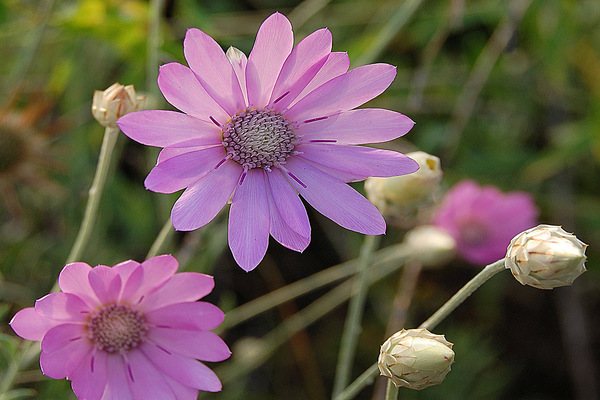

Due to its strong immunity, Xerantemum very rarely suffers from any diseases and harmful insects. The only thing that can destroy the plant is rot that develops on the roots of the flower, in case of excessive watering and stagnation of water. It is impossible to cope with rot, the plant must be removed along with the roots and destroyed. As a preventive measure, it is necessary to regularly loosen it, which will allow the earth to dry out better. If the weather is rainy, then you can cover the plant.
As for pests, the plant can be found
- The root gall nematode is a very dangerous small worm that is extremely difficult to spot. This pest settles on the root system and kills it. Wet soil at a temperature of +18 degrees can provoke the appearance of a worm. You can understand that the plant needs help by the fact that the plant stops growing, the leaves twist and the flower begins to die. All this happens because the roots cease to consume nutrients and transfer them to the plant. When signs of this insect appear, it is necessary to immediately treat the plant with insecticides;
- Leafy aphid- green or black midges sucking out all the juices from the leaves, eating them and the buds in which the flowers are blocked. Its reproduction takes place within a short time, which is why the plant can die quickly enough. As soon as these insects appear, it is necessary to treat the plants with insecticides as soon as possible.
All these troubles can be avoided by following the rules of watering, clearing the land of weeds and observing the distances when planting.
Use in floristry
Often, xerantemum is grown for cutting to create compositions, bouquets, both fresh and dried. Due to its excellent preservation, the flower dries up after cutting, without losing the color of the buds and retaining the shape of the flower. In order for the xerantemum to be preserved as well as possible, it is cut off during the period when the buds are not fully opened.
After the plants are cut, they are collected in bunches and it is recommended to hang them with their buds down. Xerantemum should be dried in dark, dry rooms - only in this case it will be possible to preserve the plant.
Xerantemum in dry form is capable of maintaining a bright color and shape of buds for a long time, not less than 2 years.
Did you know?
It is possible to make dry flowers brighter, for this they use a solution of hydrochloric acid. For its preparation, take hydrochloric acid (1 part) and water
(
12 parts), mix everything thoroughly and dip freshly cut buds in this liquid for 4-5 seconds. Then gently shake and hang dry.
Xerantemum is often combined in bouquets with other dried flowers, annuals and perennials.Annual dried flowers that can be added to a bouquet with xerantemum include gelikhrizum, helipterum, kermek. Among the perennials combined with this plant, anaphalis, gypsophila, yarrow, pearl mussel, lavender and astilba are distinguished. You can add spikelets of wheat to bouquets, ornamental garden grains - breeze and lagurus, the bouquet will well complement lunaria and physalis.
Using xerantemum
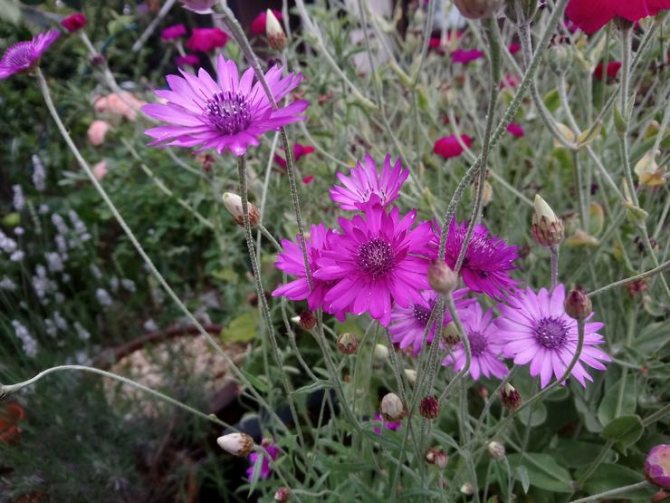

From mid-summer to the onset of autumn, the xerantemum blooms. You can see the varied colors of the baskets. These are pinkish semi-double beauties, iridescent fluffy enchantresses, magicians purple with a metallic sheen. A lot of flowers open at once, and the eye rejoices at such beauty, and even dried inflorescences look elegant and luxurious.
It is no coincidence that since the beginning of the 19th century, xerantemum has been used for decorative purposes.
Flowers are adorned with flower beds, rockeries, lawns. They are used to decorate hedges and curbs. Not a single alpine slide is complete without the immortelle. Natural compositions with yarrow, astrantia, salvia are of great interest to gardeners and summer residents.
Flower arrangements, both with live plants and dried ones, with the right approach, will delight any aesthete and admirer of beauty. Usually, other dried flowers are added to the xerantemum, they complement the bouquets with wheat spikelets, decorative cereals, which gives the ensemble an even greater effect. Often a culture is grown precisely to cut it off in time, dry it, and then use it for compositions.
The inflorescences are removed when the buds are still closed, collected in a bunch and dried, placing them in baskets down. The drying room should be well ventilated, dry and shaded. To make the result brighter, the prepared inflorescences are treated with a solution of hydrochloric acid in a ratio with water: 1:12. The bunch is dipped into the composition for exactly 5 seconds, and then shaken and dried.
Xerantemum in traditional medicine
Water infusions are used to treat the heart and internal organs. Herbal extracts will help relieve toothache. Xerantemum will come to the aid of bleeding. And earlier, they resorted to tinctures when they were bitten by insects or rabid animals.
Growing and caring for a plant
Xerantemum is an unpretentious flower, so it can be grown at home without any problems. Let's take a closer look at where to plant and how to care for an ornamental plant.
When growing xerantemum on the street, it is necessary to provide it with a sufficient amount of sunlight, therefore, the plant should be planted on the sunny side of the site, or in an area with light partial shade. In the case of growing seedlings indoors, place the container on the south window. The container is selected shallow, up to 10 cm in height, you can sow seeds in pots, at least 9 cm in diameter.
Soil and fertilizers
When growing Xerantemum seedlings indoors, the container must be filled with light, loose, moist soil; it is better to purchase it in a specialized store. A universal substrate for flowering plants is suitable for purchase. Outdoor Xerantemum prefers to grow on light, nutritious soils. Sandy and sandy soils with neutral acidity are well suited for growing this plant.
In order to stimulate the formation of buds, it is recommended to feed the plant with special complex fertilizers with a high content of phosphorus and potassium. Such fertilizer is purchased in specialized stores, used according to the instructions, which are indicated on the container with top dressing.
Watering and humidity
Xerantemum is a drought-resistant plant, so air humidity and watering do not matter much. It is recommended to water the plant only during the process of growing seedlings and after planting it in open ground, until it finally takes root. At this time, the flower is watered regularly, after the topsoil has dried.Watering is completely stopped after the plant has built up its green mass.
Important!
The flower can be watered during the flowering period only in case of prolonged drought in extreme heat.
Relation to temperature
In order for the seeds to germinate at the same time, the temperature must be at +20 degrees. It is worth remembering that the seeds can die with light frosts. The plant is cold-resistant, so it can withstand temperature fluctuations up to +5 degrees. Since the flower is annual, it is sown for 1 season, that is, wintering is excluded.
If the seeds were not collected on time and fell into the soil, then the next year self-seeding may appear if they do not die in winter. It is possible to achieve germination of seeds that have fallen into the soil in autumn only if xerantemum is grown in southern regions with warm winters.
Reproduction
You can propagate a flower by seeds. It is most effective to grow xerantemum by seedling, therefore, the seeds are initially sown in containers, which are placed in a well-lit place. Sowing takes place at the end of March, and planting of seedlings in open ground is carried out in the first month of summer. Sowing seeds in open ground is also practiced: in this case, it is necessary to sow in mid-late May, when a strong drop in temperature at night is excluded. If the seeds are sown in open ground, then the area is covered with a film until the first shoots appear. For sowing, small grooves are made in the soil (up to 3 cm in depth), sprinkling with soil on top.
Important!
It is necessary to understand that when growing seedlings in open ground, it is possible to achieve flowering of xerantemum only in the last month of summer.
When growing seedlings in an apartment, the container is chosen not deep, it is filled with a purchased substrate up to 8 cm in height, while the seeds are sown to a depth of no more than 0.5 cm. Cover the container with a film or glass jar.
Sprouted seedlings require thinning both indoors and outdoors. In the case of growing seedlings in large containers, young seedlings dive in 3 pieces, transplanting them into a separate pot with a diameter of at least 9 cm along with an earthen lump. When grown outdoors, seedlings are not dived, then the site is covered with a dense carpet of xerantemum.
Xeranthemum is an annual crop from the Asteraceae family. The plant has been known since the end of the 16th century. It comes from the southern regions of Europe. However, in Russia it has become very widespread due to its unpretentiousness.
Xerantemum is also called dried flower. This is due to the fact that it is usually used in dried flower bouquets. The culture is sun-loving and cold-resistant.
The erect stem is about 60 cm high. It is covered with whitish villi. Inflorescences are represented by single baskets. These baskets are hemispherical. Ornamental plants usually have double or semi-double inflorescences. Possible colors: white, purple or pink. The flowers are small, their diameter does not exceed 3 cm. The alternate leaves are usually elongated. They can also be lanceolate.
Flowering begins in July and ends in September. Flowering is abundant. Even after drying, the flowers retain their shape and color for a long time. Xerantemum is often used not only for bouquets, but also for decorating garden plots and flower beds.
The seeds of the plant ripen at the end of summer. They are very small in size. There are usually about 700 seeds in 1 g. They are able to remain viable for up to 3 years.
Xerantemum
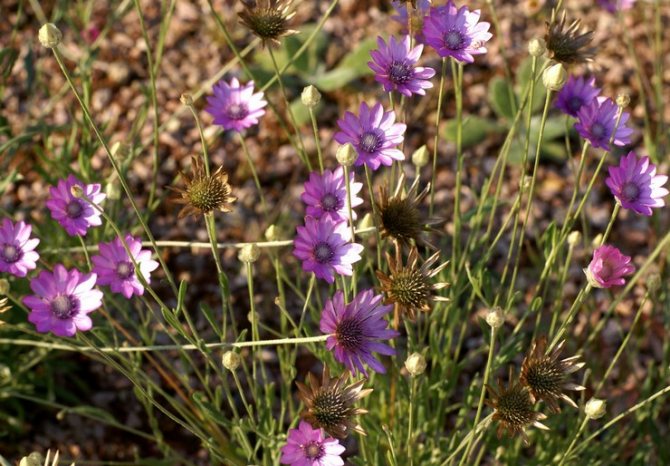

Xeranthemum is an annual flower that belongs to the Aster family (Compositae). The flower of xerantemum is sometimes called by the people an immortelle, a dried flower, a dried flower. The habitat is the countries of Asia Minor, Southern and Western Europe. It can be seen frequently in the Balkans and the Mediterranean.The culture prefers steppe expanses, sandstones and chalk deposits, low-mountain and dry slopes.
The plant has a straight stem of a silvery shade due to the fluff that covers it. The height of the arrow is about 60 cm. The leaf plates are long, wide in the middle, without petioles and covered with villi.
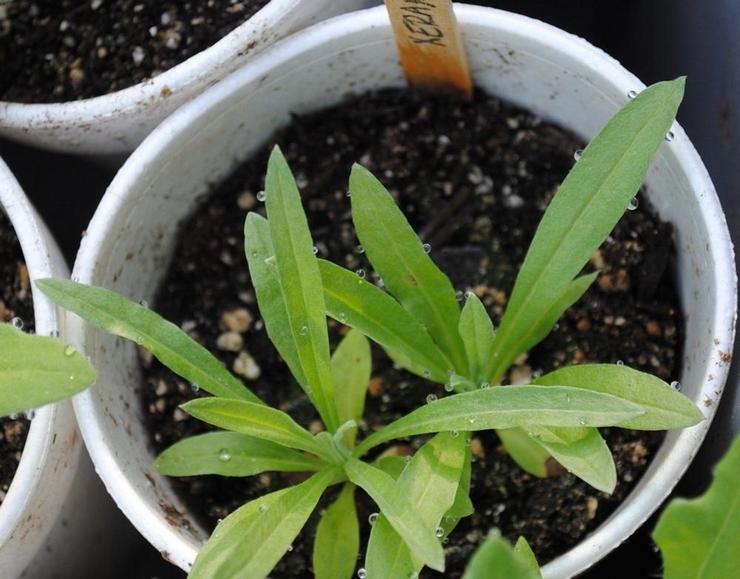

Despite the fact that the plant is unpretentious and can develop on its own, good care will provide xerantemum with only positive properties and will contribute to the popularization of the culture.
The culture propagates only by seeds, which can be immediately placed in open soil or previously grown seedlings from them. The seeds of the immortelle are very small. 1 g of them contains about 700 pieces. Grains retain their germination capacity for up to 3 years. You can collect them at the end of summer. By this time, the seeds are finally ripe.
Sowing seeds
Sowing is carried out in the last week of May. In this case, flowering will begin in a month. In a dedicated area, recesses up to 3 cm are prepared, which are watered with warm water. When the moisture has been absorbed, you can decompose the seeds and sprinkle them with earth. And then the crops are covered with foil. This will speed up the germination procedure.
You need to plant when the temperature is already at least 20 degrees. With light frosts, crops may die. But even the temperature of +5 degrees is not terrible for the grown sprouts. If the winters are warm, then autumn sowing of seeds is possible.
Seedling preparation
- They begin to grow sprouts from seeds at the end of March. In this case, the xerantemum will bloom in July.
- For these purposes, a tray with a height of no more than 10 cm is used, filled with a nutrient mixture for crops. After moistening the soil, seeds are placed in it to a depth of about 5 mm.
- The seed tray must be covered with plastic wrap or transparent glass. Every day they are removed to air the seedlings.
- For growing seedlings, a stable temperature of 22-25 degrees is required.
- Lighting should be bright, diffused.
- Constant hydration is required.
- After the emergence of sprouts, the film is removed.
- Already when two leaves appear, the seedlings are carefully transferred into separate vessels. The root system is divided very carefully.
It remains to maintain soil moisture and bright lighting and prepare for transferring seedlings to the ground, waiting for warm nights without frost. Before this, the seedlings are hardened in the fresh air. This process takes 10-12 days. The hardened plants are planted in a pre-selected area.
Types and varieties
Xerantemum has 6 types.
The most common and interesting for gardeners is the annual type of this culture (lat.Xeranthemum Annuum). This variety is commercially available as plain and terry varieties. The height of the flowers does not exceed 60 cm. Colors: white, pink, purple, red or lilac. Flowering occurs in July-September in a temperate climate. The diameter of the inflorescence is not more than 5 cm. The leaves are lanceolate and slightly silvery.
Among the varieties of xerantemum, the following should be highlighted:
- Rose
- This is an unpretentious variety. Its height is about 50 cm. Scaly flowers have a beautiful pink color. Terry inflorescences. Their diameter is about 3.5 cm. Flowering occurs in July-August. The variety requires abundant watering;
- Carmine
Is another plant variety. Grown to create winter bouquets and dried flowers. Also used in the design of flower beds, borders and mixborders. The stems are about 60 cm high. The flowers are deep purple in color. Even after drying, the inflorescences do not lose their color. The variety is cold resistant and prefers the sun. Bloom - from July to September.
Carmine
Mixtures of this culture are usually commercially available. The table below shows the most popular mixes that you can easily find and buy.
| Mother-of-pearl bouquet ... This mixture is prized by florists. Perfect for creating dry bouquets, they are also involved in the design of flower beds. Inflorescences can be lilac, white or pink in color.They do not exceed 4 cm in diameter. The variety loves the sun. Also resistant to cold. | "Gavrish" |
| Winter tale - Terry annual Russian selection. The mixture is colorful. The height of the branched stems is no more than 60 cm. Terry inflorescences are pink, purple, purple and crimson. The cold-resistant and light-loving variety is used in decorating borders and rockeries, but its main application is cutting into winter bouquets and dried-flower compositions. | NGO "Gardens of Russia" |
| Kazachok Is another popular blend sold in Russia. Terry inflorescences. Colors: white, pink. Colors and shades are very rich. It is grown for cutting and for flower beds. The variety prefers the sun and is not afraid of cold weather. | "Sedek" |
Kermek
Kermek deserves special attention. If I go to all dried flowers just like that, then to this - with a bow.
This amazing plant is equally picturesque both in a flower garden and in winter compositions.
Basically, kermeks are rhizome herbaceous perennials, less often - shrubs and biennials, which are grown in our region in an annual culture.
Stems are branched, rounded, angular or winged. The flowers are small, pink, purple, purple, yellow, collected in dense or loose ears, which form corymbose or paniculate, often globular inflorescences. Bloom from July to October.
Our advice:
Photophilous, drought-resistant, mostly frost-resistant. They prefer light, well-drained sandy or loamy soils.
Propagated by seeds, perennial species - by dividing rhizomes.
Growing from seeds
Growing seedlings will require a wooden box or plastic container. It will be better if the container is shallow. Sowing seeds is required in March or April. The soil should be loose and moist.
Seeds are sown to a depth of no more than 1.5 cm. After sowing, the containers must be covered with foil.
When the seedlings reach a height of 3 cm, they are dived into shallow pots. Their depth should be no more than 10 cm. If the climate is warm, then diving can be avoided by planting seedlings directly into open ground. However, this should be done only in warm weather so that the plants do not die. Planting in open ground is required in May or early June.
Planting xerantemum in open ground
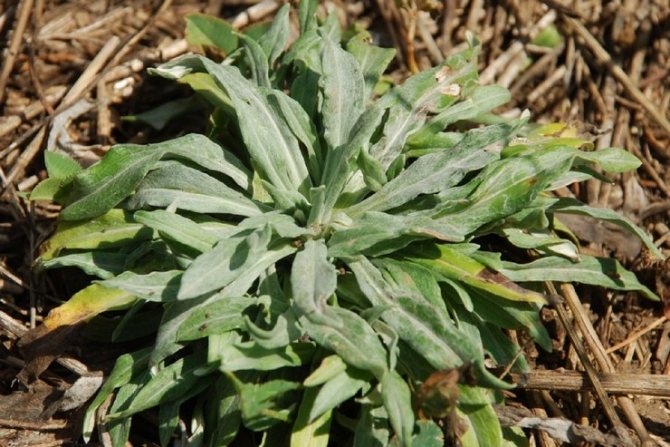

In order for the xerantemum to delight with lush flowering, when choosing a site, they focus on the following points.
- Bright sunlight throughout the day.
- Nutritious neutral soil, light and loose. These types include sandy loam and sandy lands.
The grown seedlings are transferred to the soil at the end of May, to the intended area. Saplings are transferred together with a lump of earth into holes prepared in advance. The soil around the young is tamped with palms. The root collar must be positioned at the level of the soil surface. The seedlings are distributed in such a way that the distance between them is more than 20 cm.
Planting and leaving
Planting in open ground is carried out no earlier than May. The main thing is that the time is warm. Xerantemum is not picky about the soil, but it is better to choose nutritious and light soils. It is necessary to plant seedlings in places that are rich in sunlight, since the plant loves light very much.
During the growing season, it is important to control that the soil is moist. But during the budding period, you should not water the plant abundantly. It is desirable that the soil is dry. Also, during the flowering period, the watering process should be limited.
Flowering occurs in July or closer to August. If the climate is warm, then it is better to sow seeds directly into the open ground, since Xerantemum does not like transplanting.
In addition to watering, it is also necessary to loosen the soil and remove weeds regularly.
Diseases and pests
The immortelle has high immunity to diseases and pests. Dampness (prolonged rainy weather, excessive watering) can provoke rotting of the root system and stem.It will not be possible to "cure" the plant, so keep an eye on the level of soil moisture; in case of prolonged rains, you can even build a temporary shelter, loosen the soil more often so that it dries out faster.
Among the few are:
- Gall nematode is a microscopic worm that infects the root system. They settle in moist soil when the temperature is between 18-25 ° C. Yellowish growths appear on the roots, the root system ceases to function, the growth rate stops, the leaf plates curl, over time the plant dies. It is necessary to carry out treatment with an insecticidal preparation (for example, Phosphamide, Mercaptophos), following the instructions on the package.
- Leaf aphids are small green or black midges. They feed on plant sap, eat leaves and flower buds. Aphids multiply rapidly, they can very quickly destroy both young and adult plants. Act immediately: treat the plantings with an insecticide (Confidor, Aktara, Tanrek are suitable).
It is better to prevent unpleasant phenomena than to deal with their consequences. Avoid waterlogging of the soil, do not thicken the planting, regularly remove weeds.
Xerantemum in bouquets, collection and drying
The crop is usually grown for cut. With the help of it, beautiful flower arrangements of dried flowers and winter bouquets are created. They are able to retain their color and shape after drying.
Plants are cut at a time when the buds have not yet fully opened. They are collected in bunches and hung to dry. The drying area should be dark and dry.
For several years, dry xerantemums retain their bright color and shape. If you want to give the flowers a brighter shade, then you can use this recipe: before drying, lower the buds for a couple of seconds in a weak solution of hydrochloric acid. For 1 part of hydrochloric acid, you need to take 12 parts of water. Then shake the flowers and dry in the usual way.
Bouquet of dried xerantemum.
Decorative cereals
There are also a number of beautiful plants from the group of dried flowers - Gomphren Globa and Gomphren Haage, annual lonas, acroclinulen Mangls and Humboldt, celloses, winged ammobium, etc.
But just as a beautiful stone without a cut and like an orchestra without a second violin does not evoke in us a delightful feeling, a special charge of emotions, so a flower garden or a winter composition does not breathe that lightness, completeness from which it takes our breath away if there are no decorative grains in them.
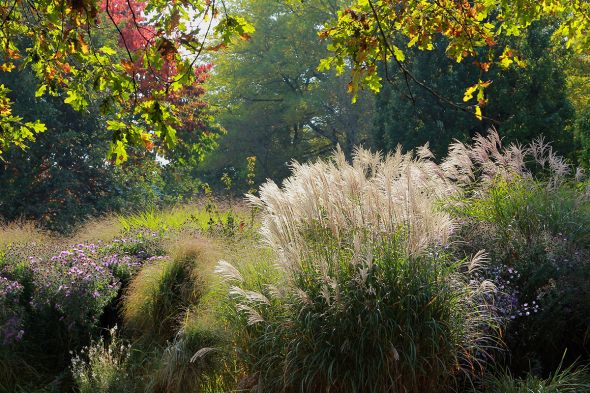

Our advice:
Cereals are an obligatory attribute of winter creations, in which they play not only the role of a filler, but sometimes they do an excellent job with a solo part, carrying the main semantic load.
What is dried flowers
Any flowering plant that has passed the stage of drying can be called a dried flower, but this is only theoretically. In fact, the integrity and aesthetics of many plants after they have been cut and dried is questionable from a floristic point of view.
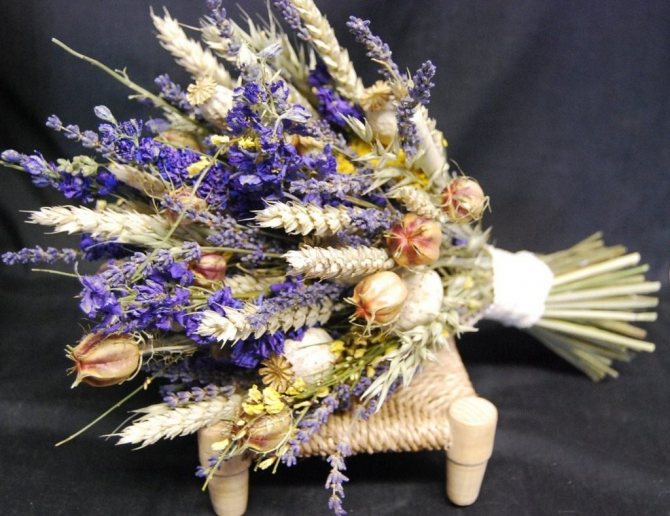

Most habitual garden dwellers do not survive drying out well.: their leaves and flowers acquire a faded shade and quickly fall off, so it makes no sense to talk about drawing up any aesthetic composition in this case. For beautiful artwork that will last really long, only a few types of flowers are suitable.
Interestingly, in this case, you can use not only flowers, but also leaves and even seed pods.
Anafalis
Anafalis pearl is found in the middle lane. It has narrow leaves. The stems reach a height of 45 centimeters. Fully covered with down. This creates a silvery veil effect. The baskets are small, up to 8 millimeters. The silvery-white flowers are arranged in inflorescence cords. Anaphalis is spreading rapidly. Cold resistant. It continues to bloom in light frosts. The plant is perennial.
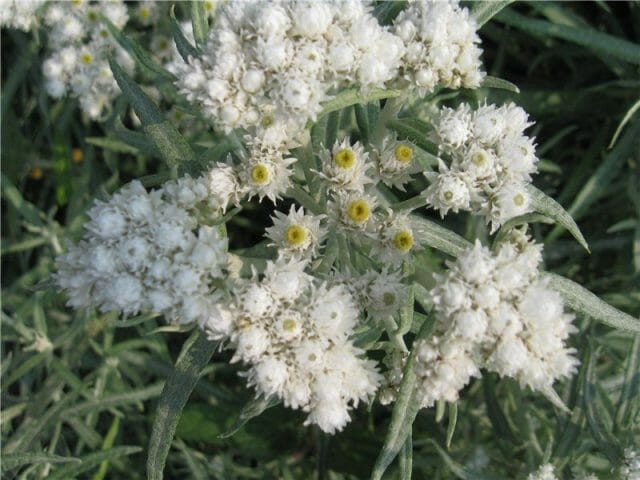

Anafalis
Photo gallery
Compositions
Yet how interesting it is to experience the feeling associated with the cycle of work carried out.After all, everything is done by hand - from planting seeds, growing, to drying and making creative compositions. Nice feeling, isn't it?
The result is very dear to you and inspires new feats... Therefore, I want the bouquet to last as long as possible. The created paintings and panels will delight you for a very long time if you place them under glass. However, they do not look the best way, somehow "museum".
What to do? Of course, if the painting is not protected from dust, it will not be stored for long. But after a year, it will still lose its unique aroma and freshness, and after another year and aesthetic appeal. Therefore, do not store the compositions for years, because in addition to harm to health, especially if there are allergy sufferers in the house, it is simply not hygienic to store it for so long. Better to grow a new batch of flowers and make a fresh composition to replace the old one. Since you are now an experienced designer, it will come out better than last time!
Grow dried flowers, these wonderful plants, and enjoy their beauty not only in summer, but also in winter.
klumba.
Gypsophila
In floristry, the most common gypsophila paniculata (Gypsophila paniculata) or kachim. This is a perennial plant that forms lush openwork bushes in the form of a ball up to 100 cm in diameter. They consist of numerous thin, branched shoots ending in tiny white flowers that bloom in July and bloom for up to 45 days. There are garden forms with double and pink flowers.
Bouquet with gypsophila
A lot of varieties have been bred: 'White Cloud', 'Snow Flakes', 'Carmine', 'Flamingo', 'Mirage', 'Akulina', 'Rosenschleier' ('Rosenschleier'), 'Pink Star' ('Pink Star') , 'Rosea' ('Rosea') and others.
You can find a large selection of gypsophila seeds in our market by clicking on the link.
Growing flowers for a winter bouquet
Some weather-resistant annuals, thorns and most cereals sow before winter. Most types of heat-loving plants are planted with seedlings in warm ground. But there are those that manage to develop from seeds sown in late spring.
In order for the flowers to grow well-formed, without deformations, try to organize proper care for them. The recommendations can be found on the packaging with seeds, there is such data in special literature, as well as on the Internet.
It is necessary to grow dried flowers with the introduction of complex fertilizers. This will allow you to get full and abundant flowering with developed peduncles. These plant species are fed three times per season. It is not necessary to water such flowers and cereals, since most of them do not tolerate waterlogging of the earth.
Ammobium
The homeland of this variety is Australia. Known as Winged Ammobium. Our climate allows the annual to reach a height of 60 centimeters. Baskets-inflorescences are small in size and 1.5 cm. The leaves of the wrapper resemble petals. They are dry white, yellow in the middle. They have a decorative appearance.
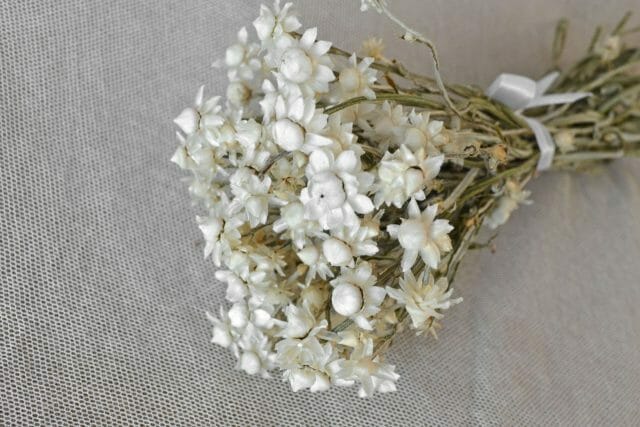

Ammobium
The variety gives abundant flowering. It begins in June and ends with the first frost. Looks beautiful as part of winter bouquets and on a flower bed.
Drying flowers
Based on the requirements for decorativeness, dried flowers are cut at different stages of development. For example, some are harvested when their peak flowering occurs, others when buds are forming, and still others when the seed pod opens, when the plant has gotten rid of the seeds.
It is better if the stem is left longer during cutting, since it is easier to shorten than to grow. The preparation of dried flowers for the future composition also implies the cleaning of unnecessary leaves. After that, the plants are divided into bunches, each tied and hung upside down in a well-ventilated and dry room.
So that the flower can be further painted in the desired color, you need to achieve its lightening... To do this, you need a spray bottle, spraying should be done every two days.However, the smallest atomization is required, so the mode must be set correctly. Also, instead of a spray bottle, a bottle of eau de toilette with a spray is used.
Cereals will dry out perfectly in the open air, in the sun. However, they must be protected from rain and fog. In this case, spraying should be done more often, namely, twice a day. After such manipulations, the stems and spikelets will become completely white.
If the decorative tasks do not include painting and discoloration, then the natural color of the plant should be preserved. To do this, you need to dry it in a very dark room, you do not need to spray. Storage continues in the dark until use.
To create panels or paintings, dried flowers are dried using a different technique, since they must adhere well to a flat surface. For this, at the drying stage, they are given the required shape. This is done like this: flowers attached with thread or tape to unpainted wooden boards.
Before sending dried flowers for storage, they are given the desired color, special fixers and varnish are used. This further retains the applied shade, and also prevents shape changes and shedding. These drugs are purchased at flower shops.
Dried dried flowers are carefully folded into cardboard boxes, transferred with newspapers or tissue paper. Naturally, the room where the dried flowers are stored must be dry.
Rules for cutting and drying dried plants
There is no single cutting period for dried flowers. When to cut the inflorescences depends on the specific species. Florists are guided by their many years of experience. The only common thing is that by the time of cutting, the plant must enter the required growth phase: if we need flowers, then this phase will be the complete dissolution of the flower bud, and if the seed pods and fruits, then the ripening of the seeds at the end of the growing season. Drying and wilting of plants on the root should not be allowed. It is also necessary to cut off green shoots, full of vital energy.
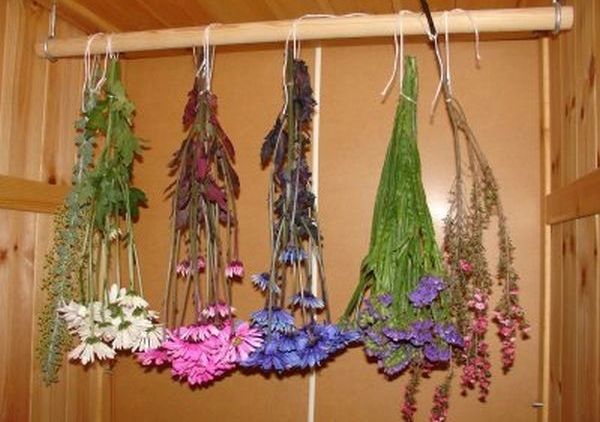

Cutting must be carried out in dry weather. Before this, a place for drying and the necessary tools are prepared in advance. The room should be dry, ventilated and dark. The brightest and largest specimens without defects and a sign of disease are chosen as material for future crafts. The inflorescences are cut along with a long shoot. The longer the shoot or peduncle, the more convenient it is to dry, and the excess can always be cut off.
To get quality material for work, you need to know how to properly dry dried flowers. Small bunches are made from cut shoots, which are tied and suspended with inflorescences down. For some species, upward drying is required (for example, for craspedia).
Without access to sunlight, dried flowers retain their bright natural color. To discolor the plants (if further staining is planned), every two days they are sprayed with water from a spray bottle with the smallest spray.
The material for paintings and panels is dried by straightening, giving them the desired shape and securing them with threads on the board. In the future, inflorescences and fruits are stored in cardboard boxes until use.
Air drying is the easiest and most affordable method, but there are alternatives. Drying with moisture-absorbing silica gel is used for large flowers (peonies and roses). To do this, the flowers are covered with a mixture of silica gel and sand and left for 3 - 5 days, checking the condition of the inflorescences daily to prevent overdrying. For the manufacture of paintings and panels, you can use the material obtained by herbarium drying familiar from childhood. More experienced amateur florists also use glycerin drying.
In floristry shops, you can buy dyes and varnishes to extend the life of the future composition.
Using dried flowers to decorate your home
Floristry allocates an important role for dried flowers, while amateur flower growers do not always imagine how dried flowers can be used in the interior.
The whole variety of floral arrangements can be divided into the following blocks:
- winter bouquet;
- picture;
- decorative panel;
- author's crafts;
- compositions in the form of baskets and wreaths.
Next, we will present a description and a master class of design examples from each block and note the features.
When looking for ways to decorate the house with dried flowers, the very first thing that comes to mind is a living bouquet in a decorative vase. This idea seems to be the simplest and easiest to implement. However, to make a bouquet of dried flowers with your own hands, you need to know some tricks. It is advisable to select a vase depending on the prevailing tones in the bouquet.
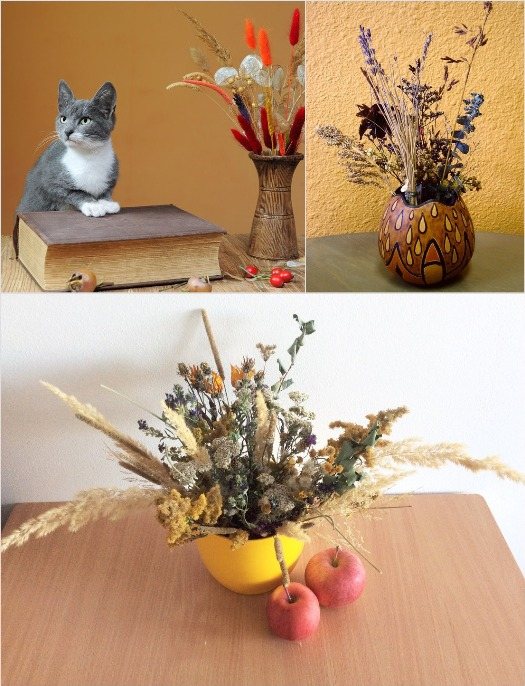

For example, light yellow “straw” bouquets go well with wood, glass and clay, and for multi-color compositions you can choose a bright ceramic vase.
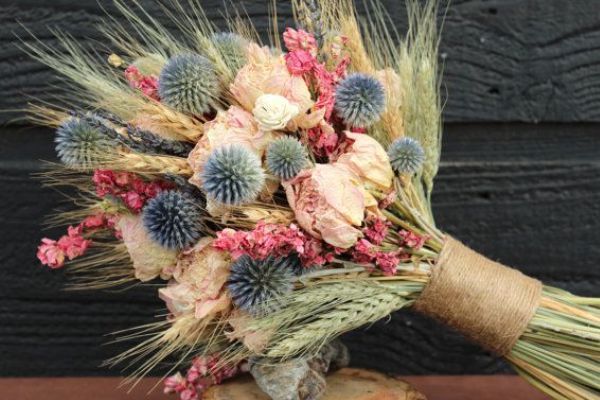

When drawing up a bouquet, shoots with inflorescences are disassembled into bunches and tied with a floral ribbon. Then the individual elements are collected in a common bouquet and also tied.
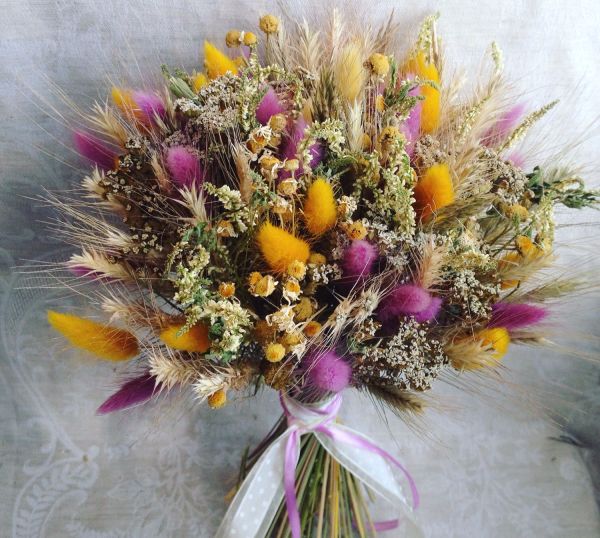

The material for paintings in the form of flat appliqués is dried by pressing. A herbarium can be made from your favorite garden flowers or you can collect wild plants. As decorative elements, you can use not only inflorescences, but also leaves, seeds, curved shoots. Any composition is laid out on thick plain paper, everything is fixed with glue and the finished work is placed under the glass of the photo frame.
Yarrow
Two types of yarrow are suitable for use in dry bouquets.
- Yarrow meadowsweet (Achillea filipendulina). Large perennial up to 1.2 m tall. He is very dressed up thanks to the dense and flat inflorescences-shields of golden color. Blooms in July-August.
Hybrid Yarrow
- Yarrow ptarmica (Achillea ptarmica) is better known among flower growers under the name pearl mussel. It is a perennial with a creeping rhizome and shoots up to 80 cm tall. Snow-white baskets 1.5 cm in diameter are collected in loose shields. Flowering begins in July and lasts 30-35 days.
Yarrow ptarmica Pearl mussel is added to dry bouquets to create delicacy and set off other flowers with its white flowers.
There are other dried flowers, which are also called lace, they give the compositions lightness and airiness. Gypsophila is in the first place here.
Gypsophila and other lacy dried flowers
Gypsophila, also known here as kachim, is not only one of the most popular veiled garden plants, but also a wonderful dried flower. The snow-white lace of her inflorescences looks great in winter bouquets, giving them airiness, elegance and weightlessness. Gypsophila is mainly used as a background culture in floristry: it sets off the bright inflorescences of other plants, in particular, basket-type dried flowers.
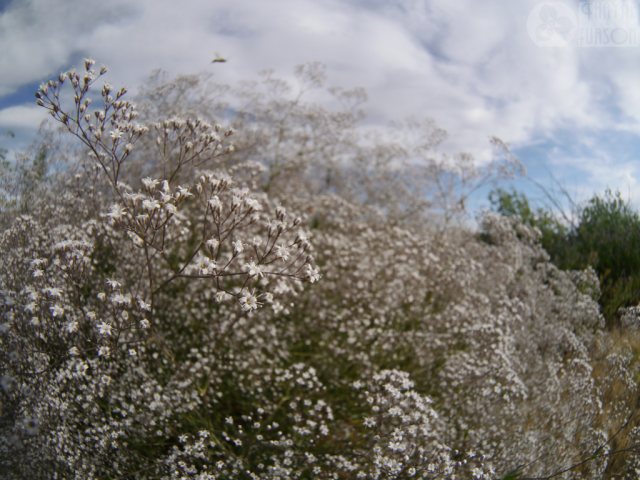

Gypsophila.
In addition to ordinary gypsophila paniculata, original varieties are also used for cutting - terry form, pink "Flamingo", dark pink gypsophila "Pink Star", etc.
Growing conditions: for cutting, you need to plant gypsophila in sunny areas in nutritious, drained and calcareous loams and sandy loams.
Required care: watering during very long droughts is needed only for young plants, while adults do not water or feed; with aggressive growth, they are limited by pruning.
Cutting time: gypsophila blooms in July-August for almost a month and a half, her inflorescences with fully open flowers are cut off; cutting into bouquets can be carried out only from the third year of cultivation.
Drying features: without hanging, in vases or jars without water, where the gypsophila is placed until completely dry, in dry and light rooms.
Plants that look like gypsophila
Kermek - annuals and perennials with very dense scutes, panicles or spheres of inflorescences consisting of numerous spikelets. It seems thicker and brighter than gypsophila, and its color palette is wider - from white to pink, salmon, yellow, blue and lilac tones in the brightest variations.
Kermek also loves the sun and well-drained soil, but requires frequent feeding. The inflorescences are cut after the flowers have fully opened up to the very frost, but they are dried only in shade, in well-ventilated rooms, hanging the bundles with the stems up. Pink and salmon flowers fade in the sun, but yellow and blue (like white) perfectly retain their color even after years.


Kermek is ordinary.
Yarrow ptarmica - the most popular type of garden yarrow for dry bouquets. It seems to be an enlarged copy of gypsophila: shining flowers seem to be a scattering of pearls on dense inflorescences. The sizes of individual flowers are larger than those of gypsophila (sometimes more than 1 cm), almost all modern varieties are double. It is also cut off after full blooming.
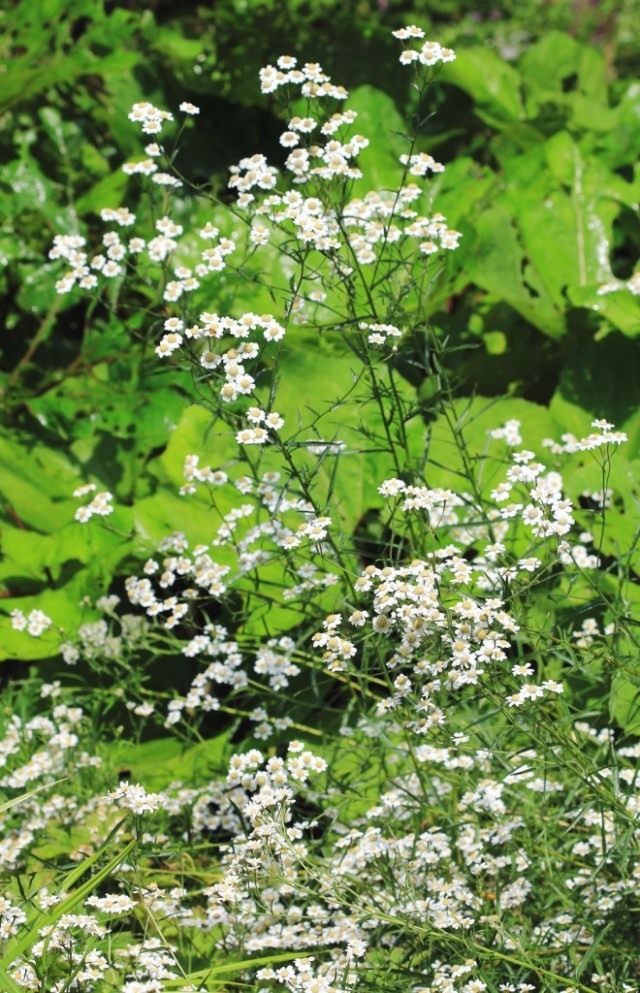

Yarrow ptarmika, or sneeze grass, common sneezer. <>
See the continuation of the list of dried flowers for winter bouquets on the next page.
Physalis
Physalis seeds are sown directly into the ground to a permanent place in April with a distance between plants of 50-60 cm. Physalis bloom in July-August.
Physalis is traditionally prized for winter compositions, which he greatly adorns with his exotic "lanterns" of a fiery red color.
The flowers are cut on a sunny summer day at lunchtime. Plants should be completely dry, without droplets of moisture after dew, rain or watering. Cut flowers to the desired degree of blooming, with a fairly long stem. Tied in bunches, they are suspended in dark, well-ventilated places with their heads down, having previously removed the leaves. Plants dry out in 15-20 days.
Types of popular annual dried flowers for a bouquet
- Acroclinium.
- Ammobium.
- Gelikhrizum.
- Gomfren.
- Amaranth.
Acroclinium roseum
Family Astrovye (Compositae). Homeland - Australia. This is a graceful compact plant 30-50 centimeters high. The stem is erect, hard. The leaves are small, elongated, pointed at the top, dull green. The flowers are very beautiful, the petals are arranged in 3-5 rows around the center.
It blooms for two months from July to September. Sets seeds well.
Seeds of Acroklinium pink are sown: at the end of April in a greenhouse for seedlings, at the beginning of May directly in open ground. The plant contains in sunny places protected from drafts and wind, with light permeable soil. With high humidity and excess lime in the soil, the plant loses its decorative effect.
Winged ammobium (Ammobium alatum)
Asteraceae from Australia. Plant height from 60 to 80 centimeters. Leaves are narrow, basal, small, oval-elongated. Stems are tetrahedral, branched at the top, with small, clustered inflorescences (2-3 centimeters in diameter), several on each shoot. The inflorescence consists of bright yellow tubular flowers in the middle and pure white outer teeth arranged in a circle in 5-6 rows.
Ammobium is propagated by sowing in early spring or autumn. Seeds sprout well, after two to three weeks, the plant blooms 60 days after sowing. The plant contains in open sunny areas, eventually grows into large beautiful bushes.
Gelichrizum bracts
Helichrysum bracts, large immortelle (Helichrysum bracteatum). From the Asteraceae family (Compositae). Dried annual flowers. The plant is 80-100 centimeters high with branched and rather strong shoots. Leaves are medium in size, elongated, rough. The diameter of the inflorescence is 5-6 centimeters. In one complex inflorescence, flowers are collected in the form of brightly colored petal-shaped scales and tubular flowers (middle) of bright yellow color.
Propagate Gelikhrizum bracts by sowing seeds in open ground in early May. Plants grown from seeds develop rapidly and bloom 70-80 days after sowing. Blooms for two to three months before frost.
Gelichrizum, like all asters, contain in sunny open places with light nutritious soil.
Gomphrena globosa (Gomphrena globosa)
Family Amaranths. Homeland - India.
Widespread in gardening and landscape culture. This is an annual low compact plant, up to 20-30 centimeters tall, with narrow, long leaves, it grows crowded in a flower bed, with a whole family. The flowers are collected in spherical inflorescences (2-3 centimeters in diameter), which seem to be one flower. The color is pink, purple, red, purple, white.
Easily propagated by seeds that are sown in a greenhouse in spring (April, May), followed by landing in open ground. Flowering is profuse and long lasting from July until the first frost. The plant grows well in open areas heated by the sun.
Gomphrene spherical requires nutritious, permeable soil and regular watering... For winter bouquets, tall varieties are used, and dried inflorescences retain their bright color for a long time.
Amaranth (Amaranthus)
Family Amaranths. Homeland - Central and South America. Amaranth is a herbaceous annual plant with long, up to 2-3 meters, stems that end in very beautiful inflorescences - lush spikelets or panicles of various shapes and densities. The leaves are rather large, oblong, pointed. The color of the spikelets is different: red, purple, violet, pastel colors.
Gomfrena
Spherical gomphrene is used as an ornamental plant. Belongs to the Amaranth family. The homeland is considered the tropical part of America. In our latitudes it grows like an annual. Shoots are highly branched. They reach a height of 35 cm. The flowers are small. They can be colored purple, pink or white. Together they form an oval or round inflorescence up to 4 centimeters in diameter.
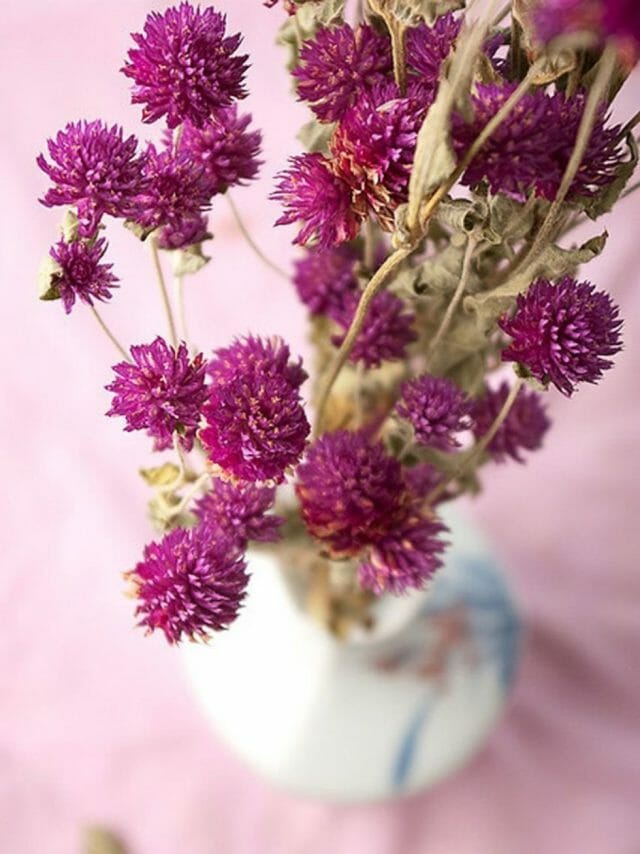

Gomfrena
In our climatic zone, the following mixtures are common: Pompom, Strawberry, High, Bright Border, Pixie Mix, Gnome, Buddy White, Buddy Purple.
Helipterum or Acroclinum
The flower has two names - pink acroclinum and pink helipterum. The birthplace of this annual is the southwestern part of Australia. It reaches a height of 50 centimeters. The leaves are formed into a rosette. Straight and branching stems emerge from it.
The baskets have a diameter of 4 centimeters. Formed by tubular yellow flowers. There is a wrapper of hard white, pink scales. They give a unique decorative look. Abundant flowering does not last long.
Inflorescences are large red-pink. The following varieties are popular in our latitudes: Bright suns, Red Bonnie, Album, Roseum, Yellow stars. Various color mixtures have been developed. For example, Bonnie's mix.
Gelichrizum
The birthplace of the flower is Africa and Australia. In our latitudes, an annual culture of Helichrysum bracteatum or Helichrysum bracts is grown. The most common variety is with large flowers. The basket grows up to 6 cm in diameter. The petals have multiple wrap. Thanks to this feature, Gelichrizum looks soft, velvety.
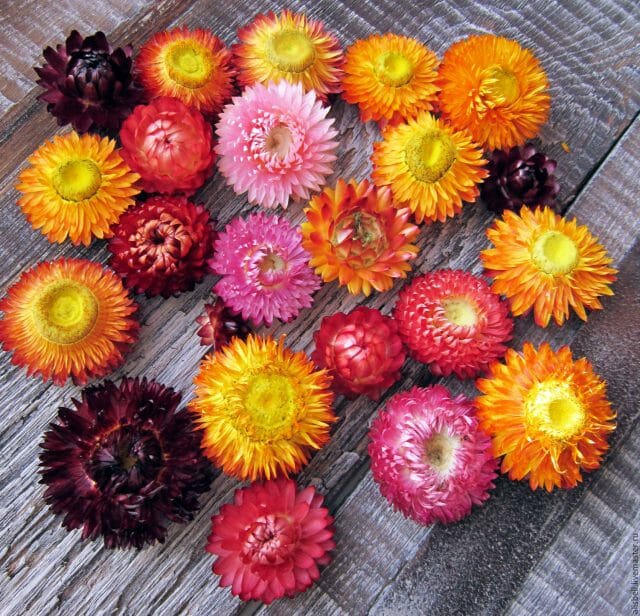

Gelichrizum
The stems are strong. They grow from 40 cm to 1 meter. Inflorescence baskets have different colors. The variety is represented by the following varieties: White, Fireball, Yellow, Lotus, Scarlet, Ogonyok. The largest is considered "King Size". It reaches a height of one meter. The undersized ones include: Hot bikini, Luteum, Moreska, Chico Red, Pink porcelain. Helichrisum helmet-shaped, daisy-shaped and Milford are also popular among gardeners.
The most beautiful dried flowers
Dried flowers - 10 most beautiful
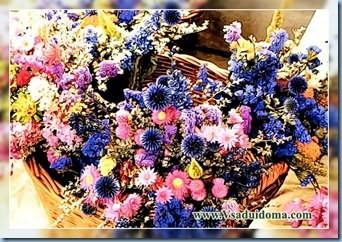

Similar articles
, Carefully arranging them with newspapers or tissue paper. Of course, the room where the dried flowers are waiting in the wings must be dry..
... These recommendations can be read on the seed bags, or found in books and, of course, on the Internet.
Most species, but more often than others, are used barley, miscanthus, corn and ovate haretail.Fragrant anthoxanthum is also used (in the last century it was called immortelle), it is distinguished by a very pleasant aroma, while its appearance is rather nondescript.
Dried flowers have always been in fashion. At the beginning of the 20th century, they were especially popular, they not only decorated interiors, but were also used as elements of a costume - to create accents in ladies' hairstyles and hats.
To obtain bright, intensely colored flowers, it is imperative to follow the technology of growing statice. The seeds of the statice are enclosed in a ribbed shell. The commercially available seed material is cleared of the fruit, but experienced flower growers who have been cultivating dried flowers for several years advise sowing the statice, spreading the ribbed fruits whole in the ground.
In the cold autumn season, almost the only flowers that delight the eye with their bright colors are dried flowers. They are popularly known as immortelles, while their scientific name is Helichrisum. Growing from the seeds of this plant by gardeners is carried out, as a rule, in large-flowered form. The flowers got their name due to the shape of the inflorescence box and bright color, because from the Greek language it literally translates as "golden sun". And people call them immortelle only because in a dried state they keep their color and shape for a long time. Now the most common are the undersized species of dried flowers, helihrizum. The cultivation of these immortelles from the seeds is carried out with the aim of forming all kinds of artistic compositions, as well as landscaping borders and flower beds. This popularity can be explained by the fact that, despite the small growth of up to 30 cm, the bright inflorescences have a rather large diameter, reaching 2 cm, and the flowering itself lasts until September.
Read also: How to prepare a hydroponic solution
MORDOVNIKIt is grown mainly because of the silvery pod septa that remain after the seeds ripen. Each of these partitions, hung on a dry stem, resembles a small moon.
I love doing floristry and creating compositions from natural materials. I grow dried flowers for handicrafts in the country. They are so beautiful that I plant them in the most conspicuous place in the front garden, which is what I recommend to you.
Before storage, dried flowers are tinted, and then special fixers and varnish are used - this holds both the applied paint and the shape of the plants, preventing them from crumbling. These specialty preparations can be purchased at florist shops.
If you want the plants to become light - and this is convenient for further coloring - then
If you usually neglect complex fertilizers for garden flowers, then in the case of growing future dried flowers, this should not be done. So that the flowering is full and abundant, and the peduncles have time to grow enough,
All of the above are traditional dried flowers. But there are also plants that have only recently begun to dry to create compositions - before their use was difficult, since during harvesting and storage they inevitably crumbled, lost their decorative effect. With the current methods of fixing the shape of dried flowers, the use of such plants has become possible.
Dried flower compositions have a special style, not to mention the unique scent of summer that comes from such bouquets.
Immortelles are sown on seedlings in February or early March in boxes with moistened soil. Seedlings are sprinkled on top with a thin layer of soil and covered with glass or film. The boxes with crops are kept at a temperature of + 16 ... + 21 degrees, watering is carried out regularly. After 1.5-2.5 weeks, seedlings appear. After the formation of two true leaves, the seedlings dive into separate disposable cups.
Origin and description
The place for sowing the mordovnik is chosen taking into account the fact that it will grow there for more than one year.This perennial is frost-resistant and is able to reproduce by self-seeding.
Lunaria is patient with low soil fertility and lack of lighting. If all the sunny places in the flowerbed are already occupied, then the lunar beauty is sown in the shade.
(More ...)
How interesting it is to follow the full cycle of work on our own experience - from planting a small seed in the ground to making dried flowers with our own hands and further composing a creative composition from them.
Plants need to be sprayed every two days
Plants are fed three times per season
These "young dried flowers" include
If you like to create something with your own hands, then you will surely like the idea of growing suitable flowers in your garden on your own, and then drying them and then making bouquets, paintings or more complex compositions from them in the winter season.
In late April - early May, the statice is planted in open ground. A place well lit by the sun is chosen. Immortelles prefer loamy or sandy, well-drained soils. Considering that the plant does not tolerate transplanting well, pits are dug, the depth of which corresponds to the height of the cup. The plastic of the container is carefully cut off with a sharp knife, the plant is placed in the prepared recess, watered with water. The historical homeland of statice is the saline Mediterranean territories, so agricultural technicians recommend adding table salt to the water at the rate of 1 tablespoon per 10 liters of water. When planting seedlings between the bushes, a distance of 25-35 cm is observed for a full vegetation of the plant.
Australia is considered the birthplace of the Helichrisum flowers. Their cultivation in Europe was started after the seeds were brought from this particular country. Despite being a perennial plant, only annual varieties are grown in our climate. The ribbed stem of Gelichrizum reaches a height of 120 cm and branches out in its upper part. Baskets of inflorescences reach 7 cm in diameter, and narrow leaves are colored dark green. Around the inflorescences of the plant there are dry petals, which are bent into the inner part with their edges. As for the color palette, it is characterized by a wide variety. Ripening of seeds of dried flowers occurs in the month of August.
The blue spherical inflorescences of the muzzle are excellent honey plants.
It is appreciated for its delicious fruits growing inside large bright boxes resembling paper lanterns. Therefore, it is most often planted among vegetables.
Simple dried flowers? No, mysterious immortelles!
The beauty of a living flower is fleeting and fragile, but there are representatives in the kingdom of Flora that have unique properties: they do not die off after the end of the growing season, retaining their lively beauty for quite a long time. And the name of these plants received a corresponding - immortelle, from the French word "immortelle", which means "immortal". This quality is reflected in the Russian names of some flowers well known to us. For example, gelichrizum is called immortelle in our country, xerantemum is a dried flower, and amaranth is called an "unfading" flower.
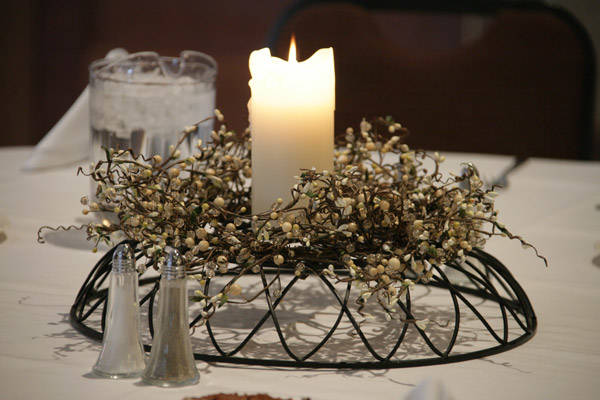

Having paid attention to the special properties of such plants in antiquity, in the Middle Ages, such plants began to be specially grown in gardens. They began to be used to compose winter bouquets, create decorative panels and compositions from floristic materials. As Europeans discovered new countries and continents, the palette of dried flowers also expanded: xerantemum and anaphalis were added to the kermek notched, then amaranths and celosia, and with the penetration of plants from Australia into Europe in the 19th century - helipterums, bracts and ammobium.
Today, a wide range of plant material is used to decorate interiors with dried flowers: ammobium, the yellow baskets of which, dressed in white wrappers, resemble miniature daisies; spherical gomphrenia with inflorescences resembling clover flowers, but with a more juicy color and a wider color range; lush panicles of kermek (limonium) of white, pink, yellow, lilac and bluish shades; and also lonas, various types of amaranths, helipterums, helichrisums, craspedia, anaphalis and many, many others. The "unfading" colors of these flowers and often their very original form help to create "dry" bouquets that preserve all the shades of sunny summer for a long time. And some "ordinary" flowers, correctly selected and dried, can also become such an original decoration.
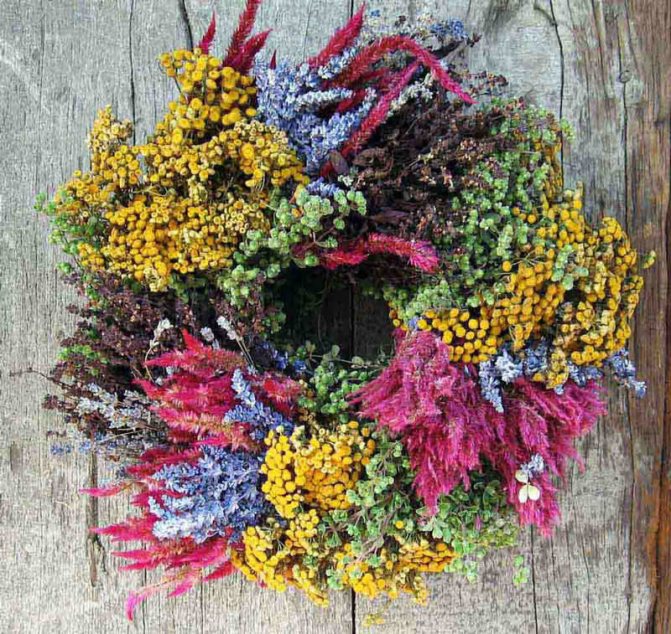

Drying plant material and creating bouquets of dried flowers requires patience, meticulousness and accuracy. In order to make it convenient to work with dried flowers, it is better to purchase special devices and tools. As additional materials, you will need glue, various paints - aniline, gouache or watercolor, thin wire, plasticine, polystyrene, various decorative wooden, glass or wicker forms and containers.
It is necessary to cut off dried flowers in a state of half-release of inflorescences, so that when they dry, they retain their natural shape. Before drying, the plants must be tied at the base in small even bundles of 10-15 pcs. The associated plants are hung upside down in a shady place protected from strong air movement for 2-3 weeks. During this period, it is necessary to regularly monitor so that the drying plant stems do not fall out of the bundle, for this they are periodically tied up tighter.
The dry stems of many immortelles are very fragile, so they are removed, and the flowers are carefully transplanted onto a thin flexible wire, bending it in the right direction so that the dried flower has a natural appearance.
There are quite a few different ways to preserve flowers, from simple drying in paper or in the microwave to applying a saturated sugar solution or egg white. You can master these methods and techniques by studying the literature on dried flowers, or in special courses.
Many of them can be grown on their own site and dried for bouquets on their own.
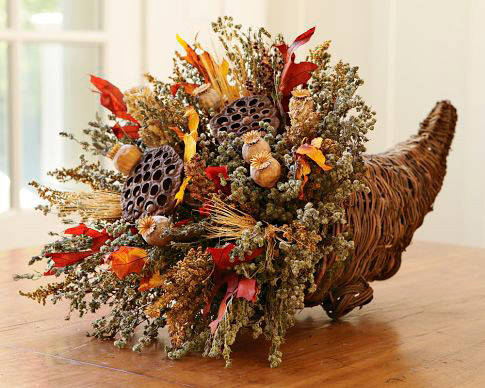

Dipsacus fullonum is also known as nap or nap. Due to its very attractive testes (heads) with a tuft on the top of the head with several encircling "hoops" of small pink flowers, this plant is often used for winter bouquets, dried flower arrangements and New Year's decorations.
Amaranth inflorescences are dried without leaves. Among the species known in culture, it is possible to note the caudate amaranth (Amaranthus caudatus), which is also called the fox's tail. It has a tall (up to 1 m) purple-red stem with bright green rough leaves and panicles of brownish-red, purple-red, dark carmine, crimson and even green hanging down almost to the ground.
In hybrid amaranth, the stem is smooth, straight (up to 90 cm), the panicle is vertical, consisting of densely spaced red inflorescences.
Amaranth paniculata (Amaranthus paniculatus). Its pyramidal, bright purple and green panicles from 20 to 50 cm in length rise on high (up to 1.5 m) stems. Although there are dwarf varieties (25–40 cm), by the way, they are the most popular.
Dark amaranth (Amaranthus hypochondriacus) differs from the previous species in more elongated spike-shaped inflorescences of reddish-purple, yellowish, greenish and brownish-cream color. There are forms with hanging panicles. The purple and greenish-purple leaves of this tall plant, reaching a height of one and a half meter, look original.
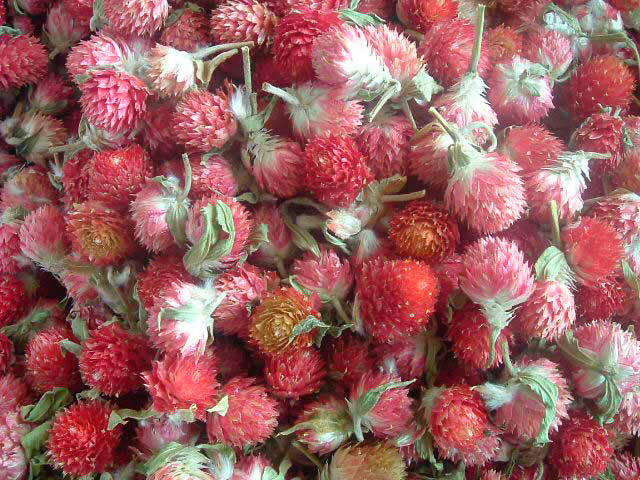

Gomphrena globosa is an annual 15 to 45 cm high, with numerous globular inflorescences of white, cream, carmine or pink, resembling clover flowers. Not so long ago, another species of this plant began to be cultivated - Gomphrena haageana, which is distinguished by larger oval-shaped red or orange inflorescences.
Gelikhrizums, or the famous "immortelles" are a very numerous genus, let us touch on only some of the annual representatives of this community. The varieties of Helichrysum hracteatum are very diverse: from low (25-30 cm) spherical bushes with numerous medium-sized inflorescences to slender plants (up to 110 cm) with large, often double inflorescences. "Petals" - membranous leaves of the wrapper - are yellow, red, orange, salmon, cream, white, pink, purple.
Helichrysum cassianum is a plant 20-35 cm high with medium-sized (1-1.5 cm in diameter) pale pink inflorescences with a yellow center. Helichrysum subulifolium - 30-40 cm high, with bright yellow non-double inflorescences and narrow leaves.
Sandy immortelle, or sandy cmin (Helichrysum arenarium) is a perennial wild plant (10-50 cm) with gray leaves. At the top of the shoots there are small cones-like inflorescences of yellow or orange color with a strong specific odor. Externally, the Tien Shan helichrysum (Helichrysum thianshanicum) is also similar to it, which also forms a bush, on which flower shoots 15-40 cm high with yellow inflorescences appear in June-July, which are larger and denser than those of sandy cmin.
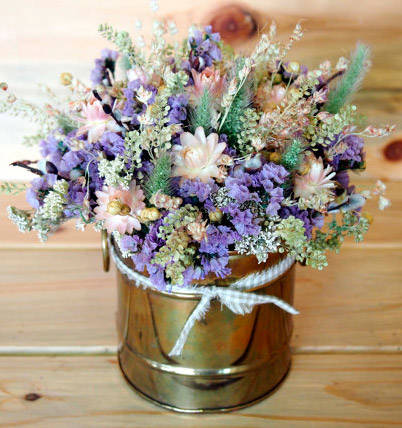

Helipterum, according to the old - acroclinum pink (Helipterum roseum) - an annual plant about 40 cm high.On numerous fragile shoots, inflorescences, very similar to Helichrisum, open up inflorescences up to 4-6 cm in diameter, with wrappers painted in pure white, pink or almost red color. Helipterum Mengles (Helipterum manglesii) or Rodante is a short (up to 30 cm) annual plant with medium-sized inflorescences-baskets (2-3 cm in diameter). Outwardly, little like its relatives, Humboldt's helipterum (Helipterum gumboldtianum) or Sanford's (Helipterum sanfordii) inflorescence resembles a yarrow. The bright color of these plants is perfectly preserved in dry form for more than one year, practically without fading.
Silver celosia (Celosia argentea) is an annual plant with large bright inflorescences of two types: feathery, resembling a torch, or comb, like a cockscomb. The color of both varieties is yellow, orange, red, purple, salmon.
Kermecs, or limoniums, naturally grow in arid regions, their flower cups have turned into membranous dry funnels, painted in bright colors of all kinds of shades. When dry, they stay on the plant for a long time. The corollas of the flowers inside them are delicate, inconspicuous, and disappear very quickly when they bloom. In some species, such as the notched kermek (Limonium sinuatum), or the Bondwellian kermek (Limonium bonduellii), flowers are collected in large elongated shields at the top of low-branched shoots. In the broad-leaved kermek (Limonium latifolium), the Gmelin kermek (Limonium gmeelinii), the Tatar kermek (Goniolimon tataricum) and the Caspian kermek (Limonium caspium), the inflorescences of small white, pinkish or lilac flowering plants are so much at the ends of the flowering resembles a fluffy cloud.
For the sake of fairness, it is worth noting that less "noble" plants can also become an excellent filling of a bouquet of dried flowers: various cereals, shy tansy with its bright yellow flowers, brick-orange sultans of horse sorrel, fluffy panicles of reed, plantain ditches or even just maple leaves in autumn colors. Physalis lanterns, original fruits of lunaria, dried inflorescences of garden hydrangea will become a spectacular revitalization of the composition and lanterns. You can also use such well-known thorns as erythematosus and muzzle.
Thanks to such a variety of dried flowers, nothing limits your imagination when creating various interior decorations from them.You can put the bouquet in a glass or porcelain vase, or any other original-shaped transparent glass container, disguising the "technical details" with moss or cones, dry rose petals, nuts or pine needles. Or you can fix the bouquet on a ceramic dish or in an original clay pot or bowl. An unexpected "vessel" for your composition can be a tray, a candlestick, a wicker basket, and even a straw hat, a pretty driftwood or an ordinary pumpkin.
Lunaria
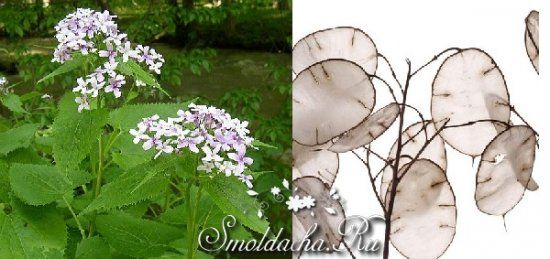

Both amateurs and professional florists Lunaria are valued for their original fruits - flat-oval hanging pods. When ripe, the thin valves, together with the seeds, are separated, and on the long stalks there are transparent membranous septa shiny in the sun. They keep on the plant until late autumn, and on cut stems they survive all winter.
Lunaria is extremely effective for dry bouquets. Lunaria seeds are sown in May. But in the first year, only a rosette of leaves is formed, and the plants bloom in the second year in May-June, the pods ripen in August-September.
For winter bouquets, lunaria is cut off when the leaves begin to turn yellow and the pods darken. The stems are tied in bunches and dried indoors, hanging upside down. After that, the outer shells of the fruits are carefully separated along with the seeds.
Photos of bouquets
For inspiration for work, we recommend that you view the following selection of photo compositions from dried flowers.
A video on how to grow dried flowers from seeds (physalis, helihrizum, shaker, statice, etc.):
The season of summer colors and floral aromas in most regions of Russia does not last long, and on gloomy and rainy autumn days and in the gray frosty winter months, one wants to return to the summer fragrant garden.
Compositions of dried flowers will help to preserve the summer mood, which will fill the house with warmth, colors and a delicate aroma. At the same time, growing dried flowers and making compositions from them with your own hands is quite simple and very exciting.
Perennial dried flowers
Plant varieties from this subgroup are very easy to dry, and also fit perfectly into any composition.
The most popular and rare perennial dried flowers are considered to be:
Anafalis
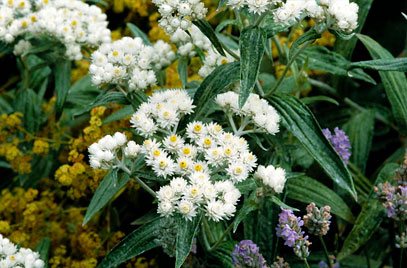

The bluish-white inflorescences of this variety of flowers can completely complement any composition. In the event that landowners are going to use it in landscape design, it is recommended to buy already grown plants, since it is very difficult to grow from seeds on your own.
It is recommended to cut the inflorescences, if necessary, drying immediately after they bloom. If this is done late, it will be problematic to dry, since the leaves may crumble.
Gypsophila
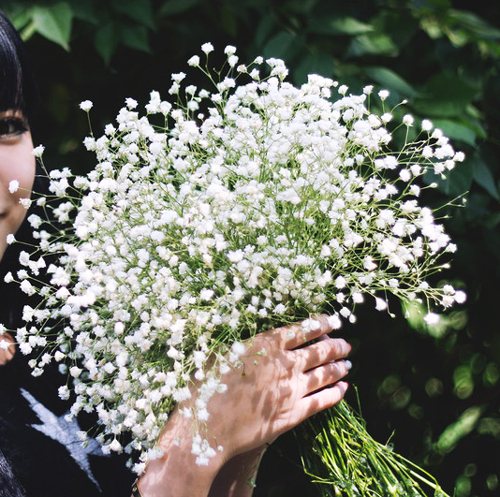

Hyposphilus in a bouquet
The perennial plant has small and non-double flowers. At the same time, the very type of inflorescence from this variety of plants has a delicate appearance, which is able to create the illusion of a kind of white cloud.
When growing it on your land plot, it must be borne in mind that it should be grown from seeds and immediately planted in open ground. This is due to the fact that she does not really like her transplant.
If it is necessary to dry it, this is done very simply. To do this, it is enough to cut the branches, where the flowers have already completely blossomed, and then put them in a vase, and wait until they are completely dry.
Yarrow
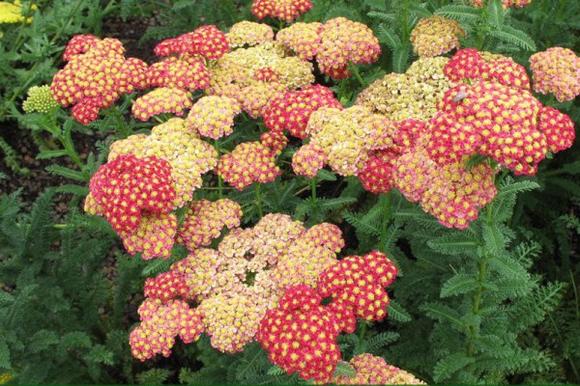

Today in nature there are many varieties of yarrow with different color shades: white, yellow, red, and so on.
This plant is unpretentious, and does not require any special care.
As for cultivation, its seeds are immediately planted in open ground from September to mid-November. Having planted in the fall - next summer it will delight the eye with its beautiful inflorescences.
"Pearl"
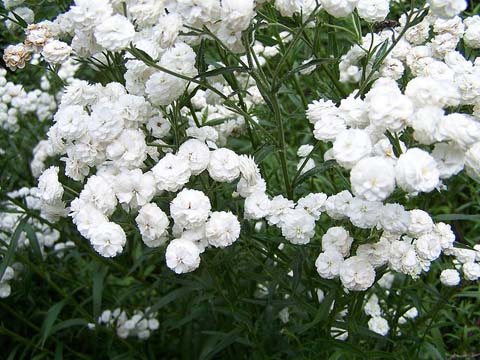

Yarrow ptarmica "The Pearl", pearl mussel.
This plant also has a popular name - sneeze herb.Another name is Ptarmika. It is a species of yarrow. It should be noted that in appearance the Pearl does not look like a yarrow. Agree, large terry inflorescences are more reminiscent of gypsophila.
But if we talk about the very care and planting, then this process is very easy. Having landed it on the open ground, it is necessary to monitor its processes every week, since it grows at an incredible speed.
To create bouquets from this plant, it is necessary to collect only those branches on which the flowers have completely blossomed. In the event that this is done 2-3 days after the dissolution, they will darken.
Lavender
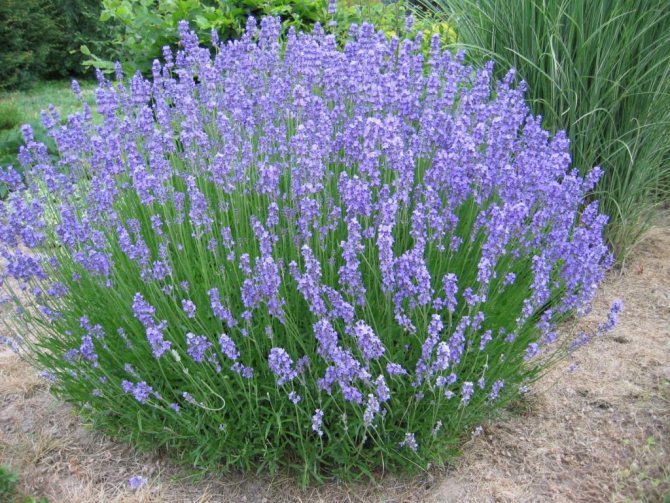

This variety of dried flowers is used in landscape design, and in the bouquets themselves, not only because of their beautiful appearance, but rather, on the contrary, because of the incredible aroma.
If you use it in dry bouquets, after cutting the branches, place them in a dark place, hanging them on the opposite side from the flowers. If you dry them in the light, the color shade will quickly lose its natural beauty and fade.
Astilba
A wonderful perennial plant that includes dense inflorescences in the idea of a panicle, which can be of such color shades as: pink, lilac, white or red.
For dry bouquets, this plant should also be dried in a dark room so as not to lose its natural beauty.
It should be noted that it would be better to use them in combination with several varieties of other colors, otherwise in a single version the composition will be very boring. Although the photo on the left refutes this.
Care and landing
Perennials do not require any special care. It is enough to ensure that the land does not dry out, and in the summer, provide abundant watering.
Growing is quite simple: you can buy ready-made cuttings or grow from seeds.
Seeds are usually sown in winter, and in spring next year they will be able to please the eyes of their owners.
From perennial dried flowers, you can achieve the following compositions in landscape design:
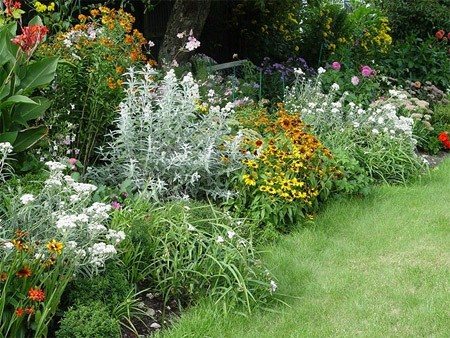

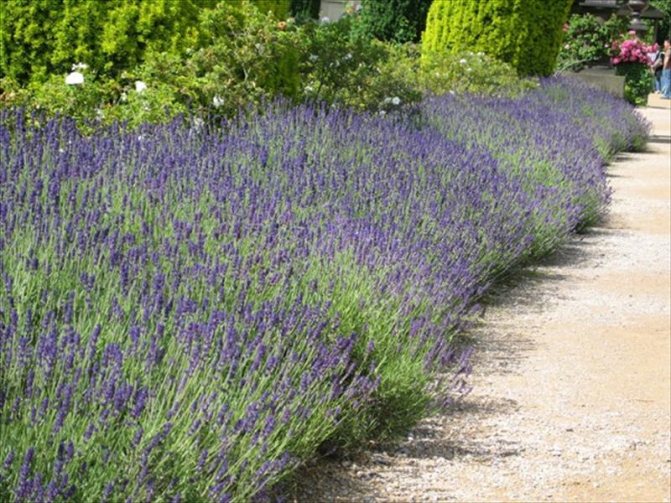

Lavender fits very well in English gardens. In this photo, she is framing a park path.
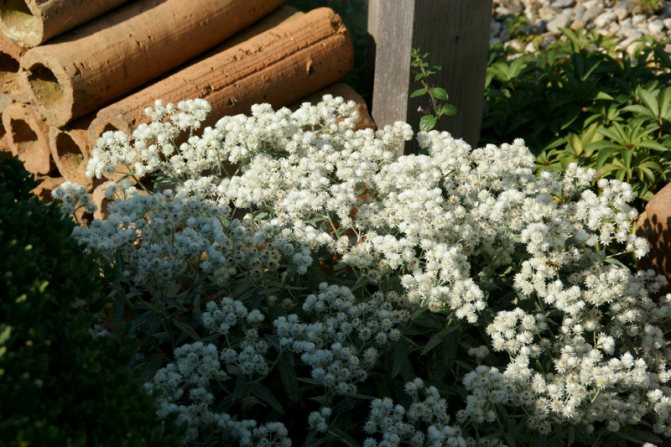

Anafalis is able to create a fairly dense coating.
Acroclinum
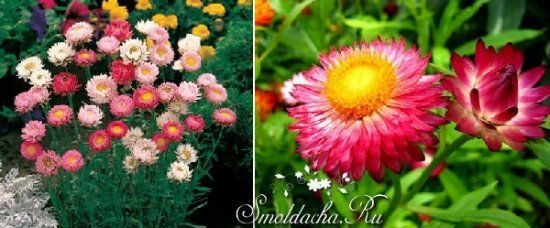

Seeds of acroclinnum are sown in a greenhouse in early April or sown immediately in an open pound in May, plant shoots appear on the 5-10th day. The planting scheme of flowers is 20 × 25 cm. The flowering of acroclinums is long - from June to frost. Acroclinum is cut for drying in a half-release on a sunny day, since in cloudy weather and with sunset, the acroclinum closes its inflorescences. A mixture of Acroclinum Terry - these are plants with graceful double inflorescences, like a daisy, which retain their color in bouquets for up to 5 years.

